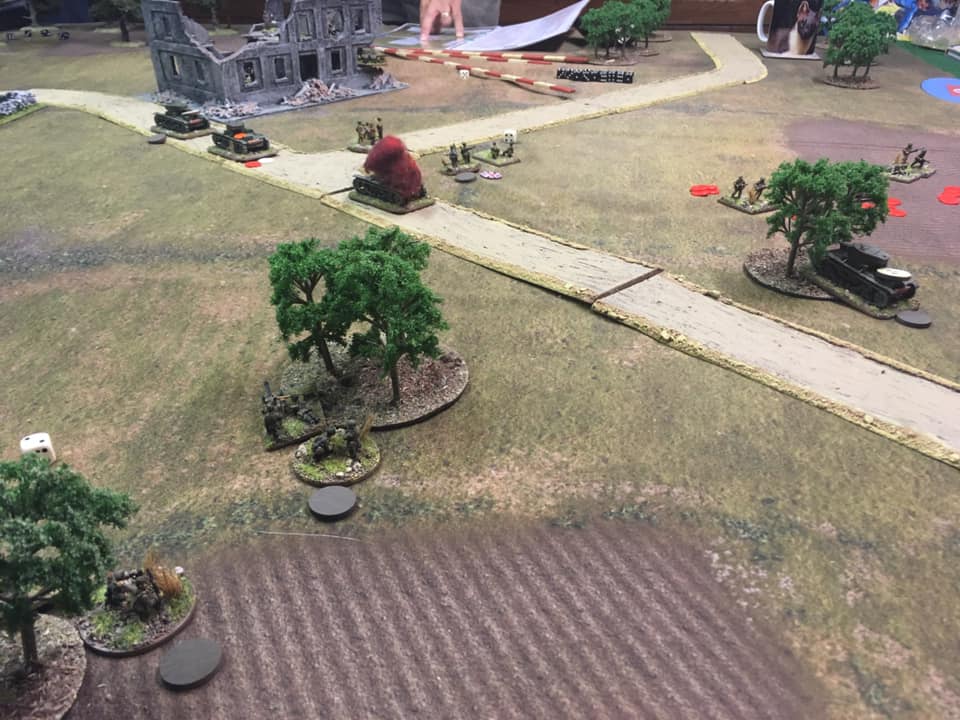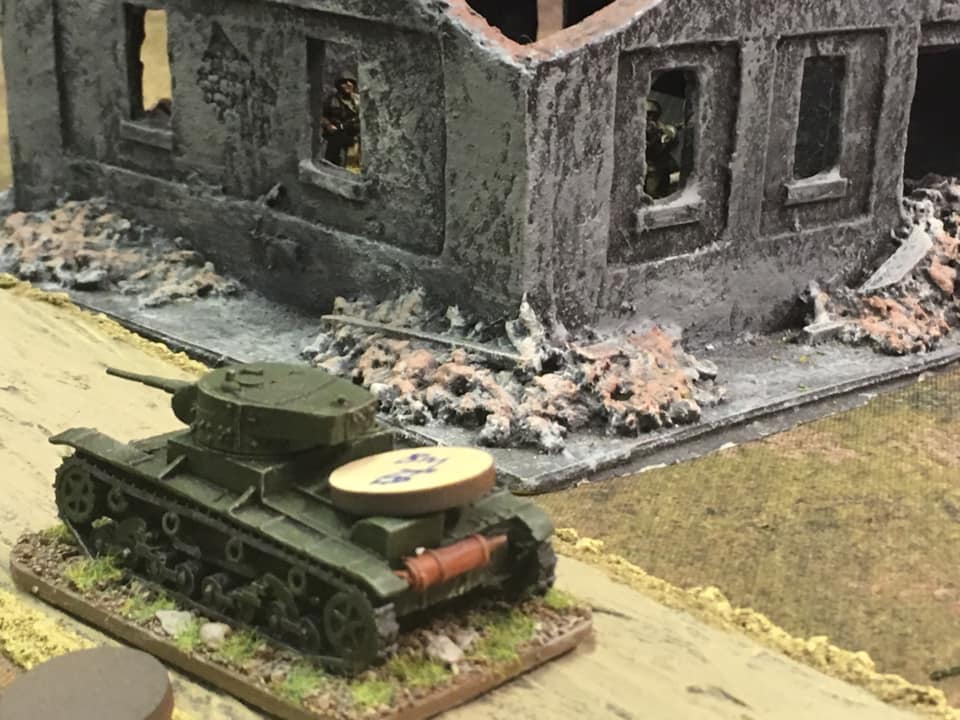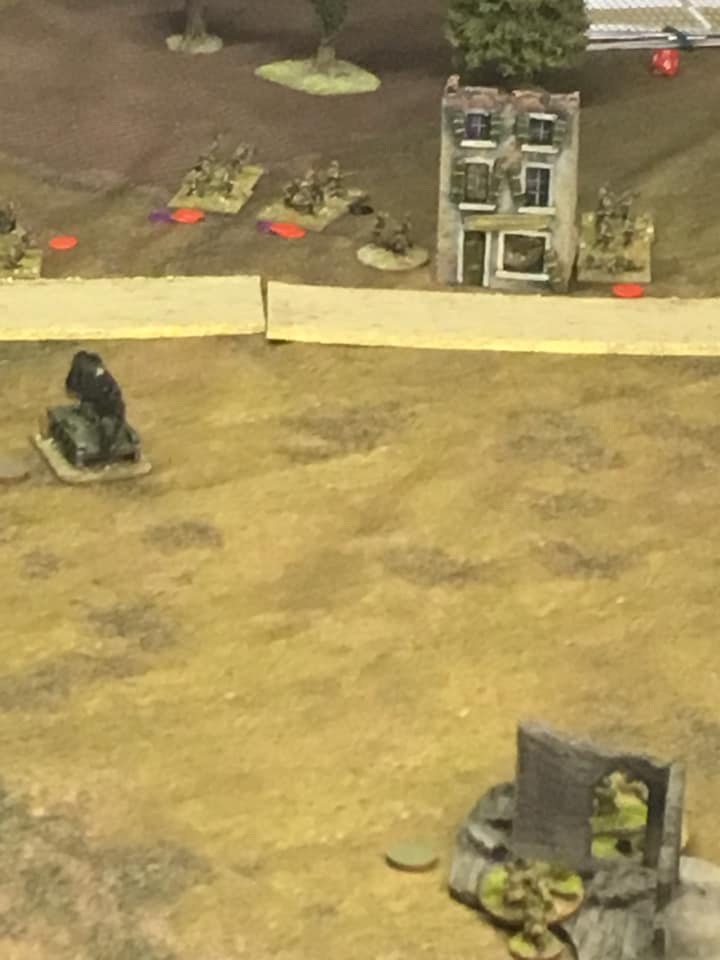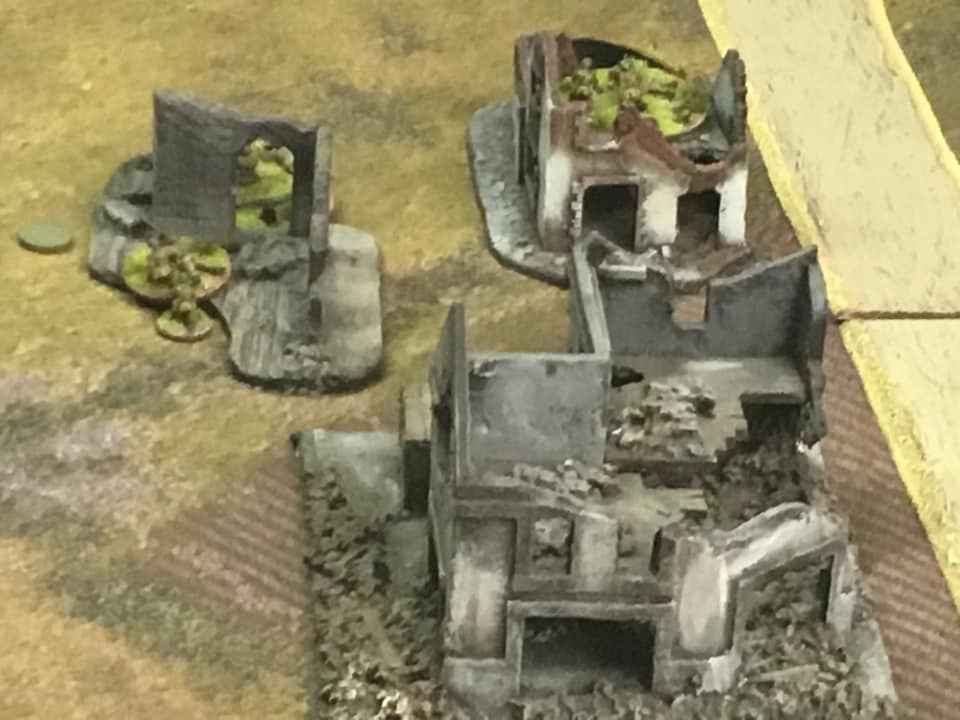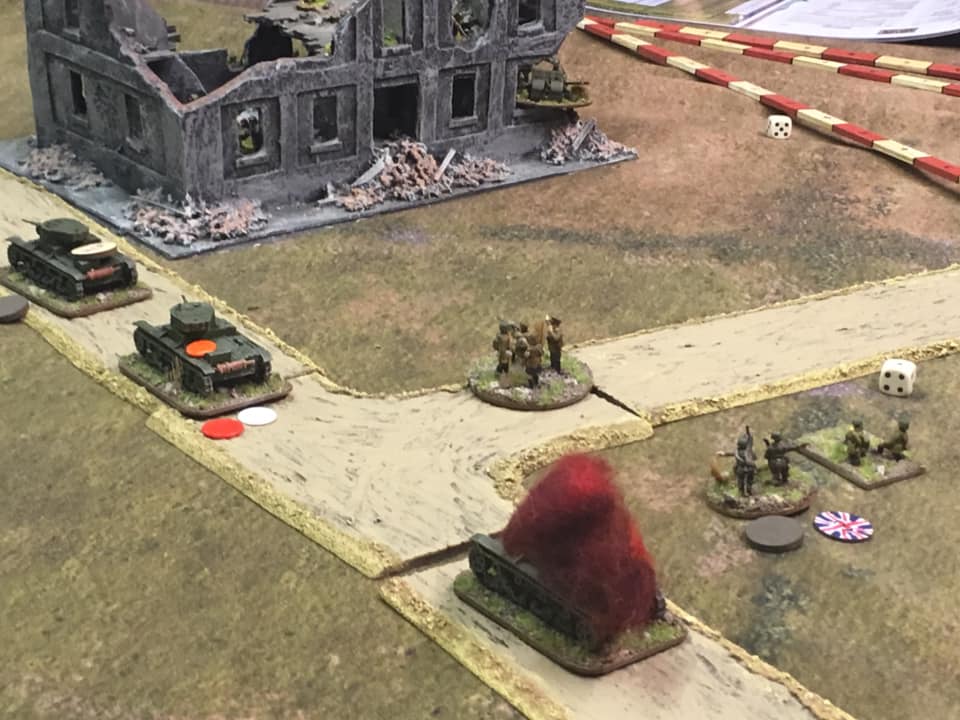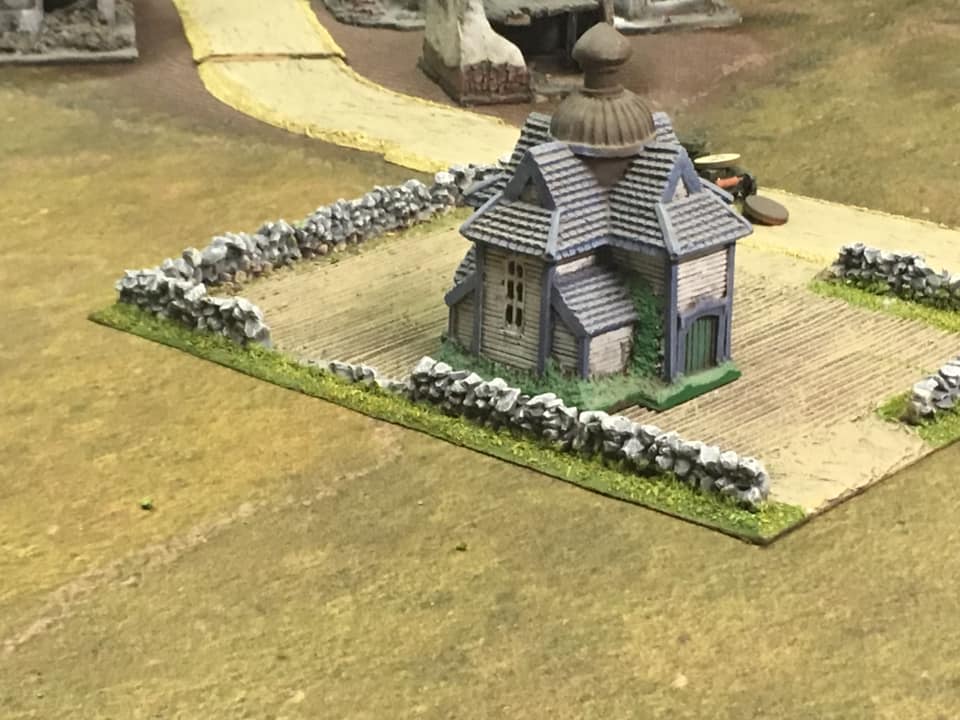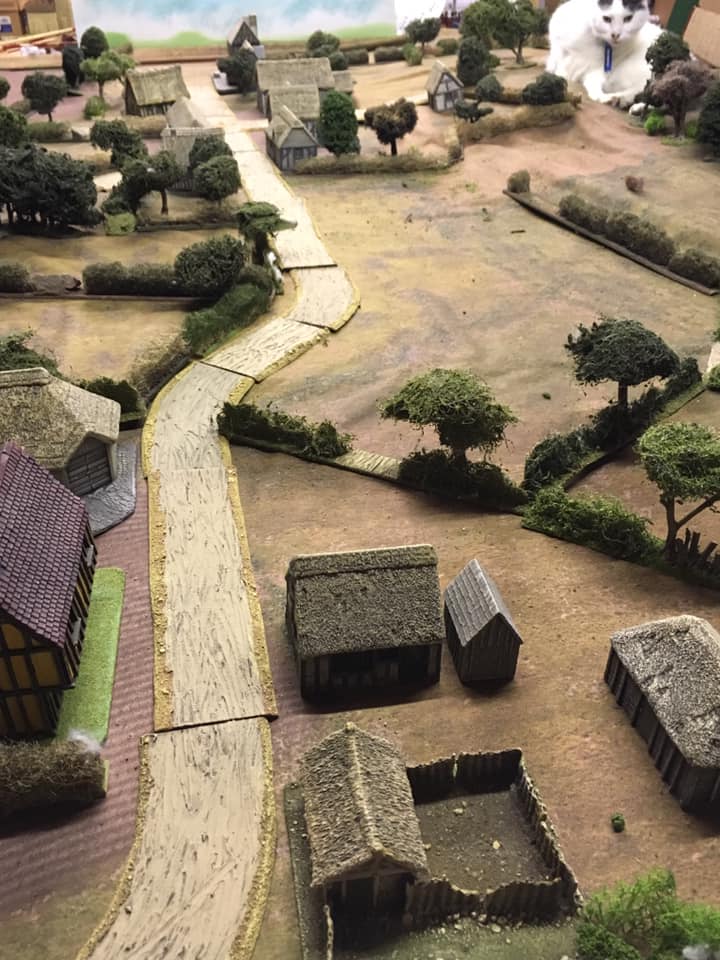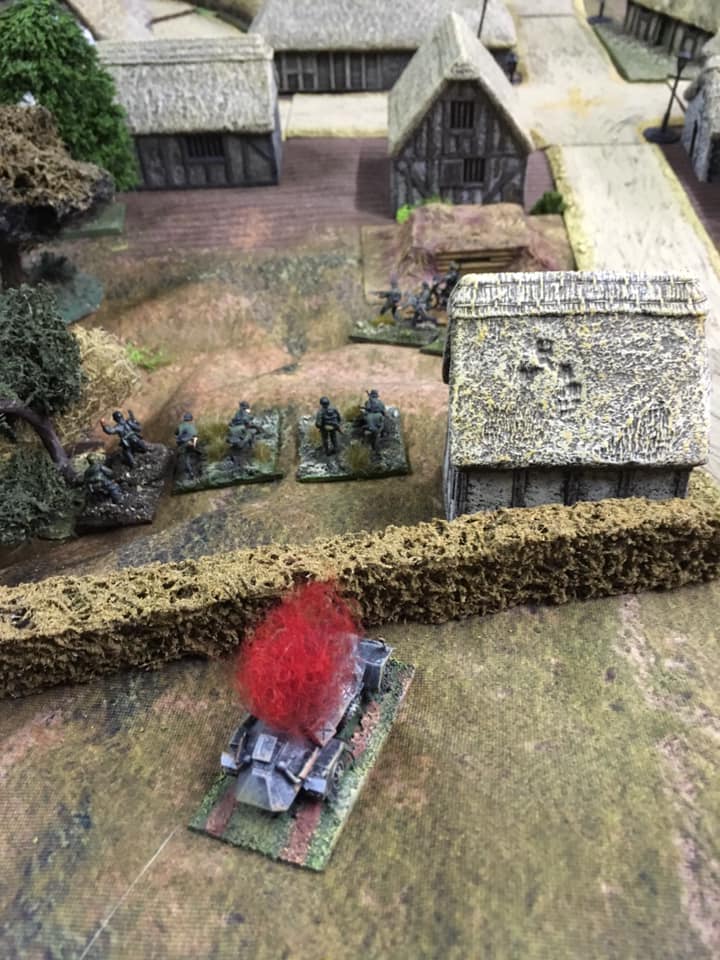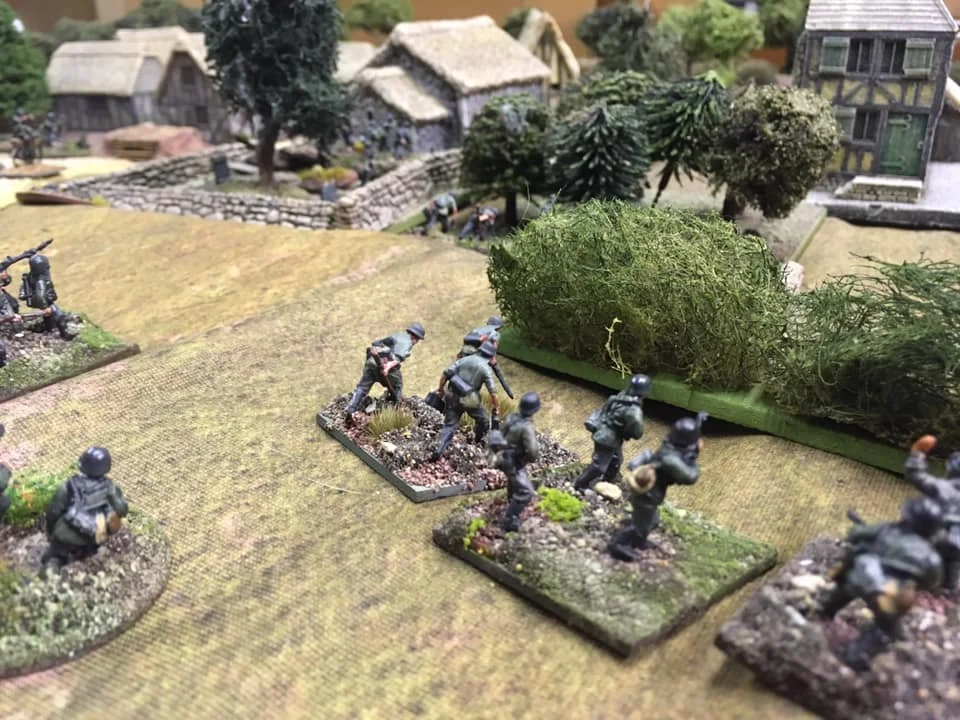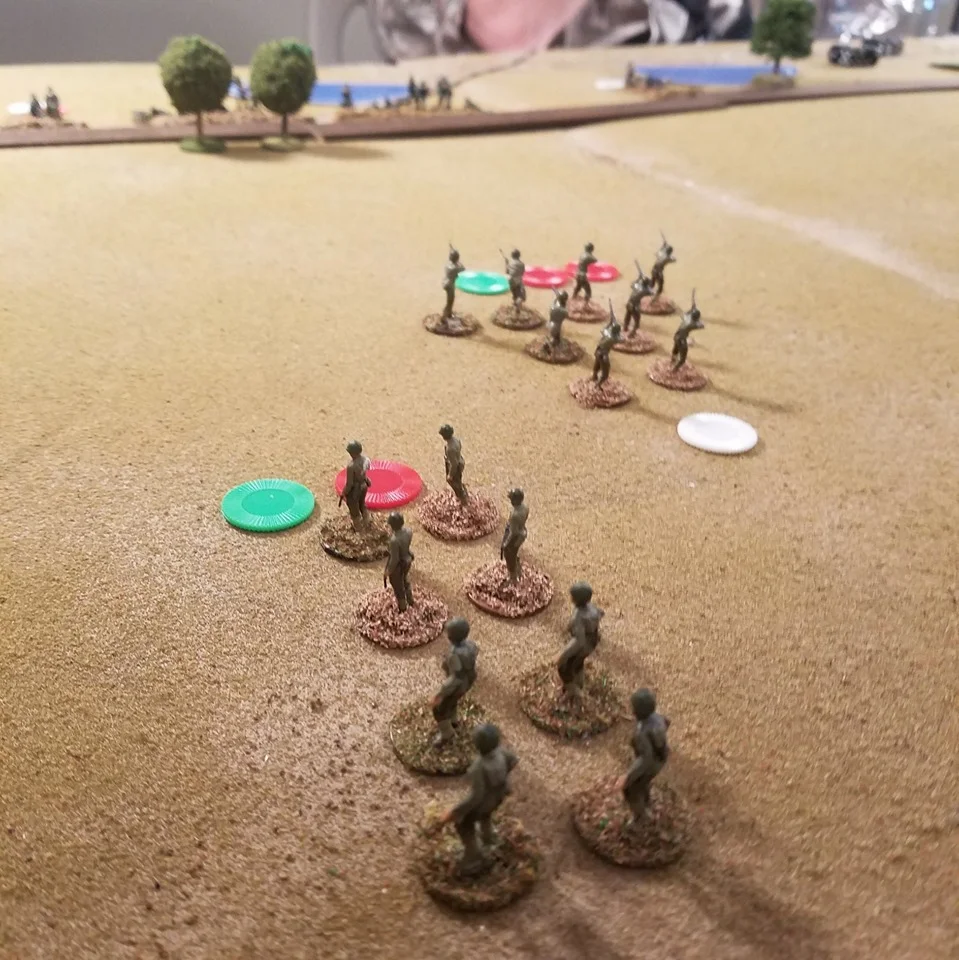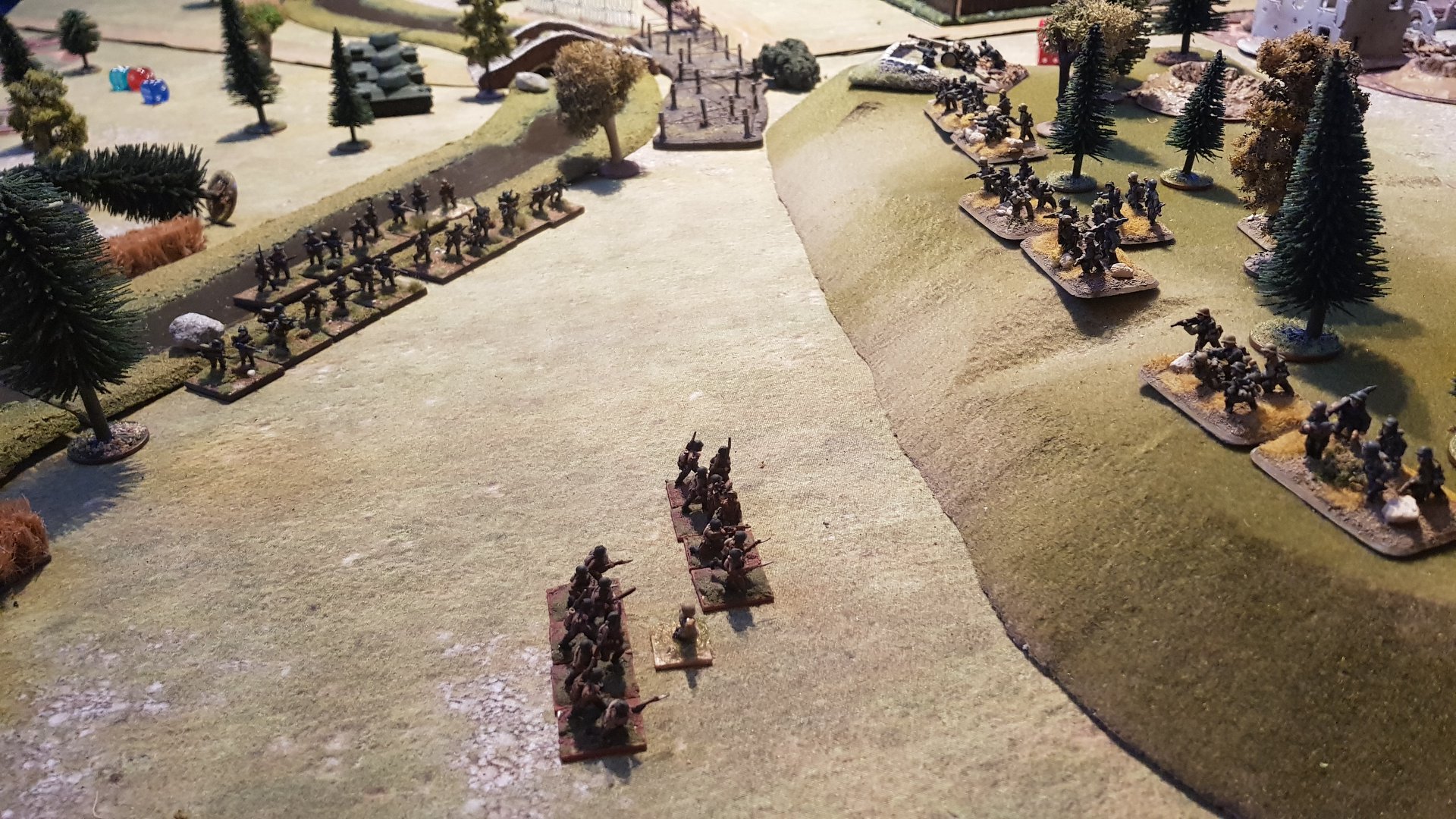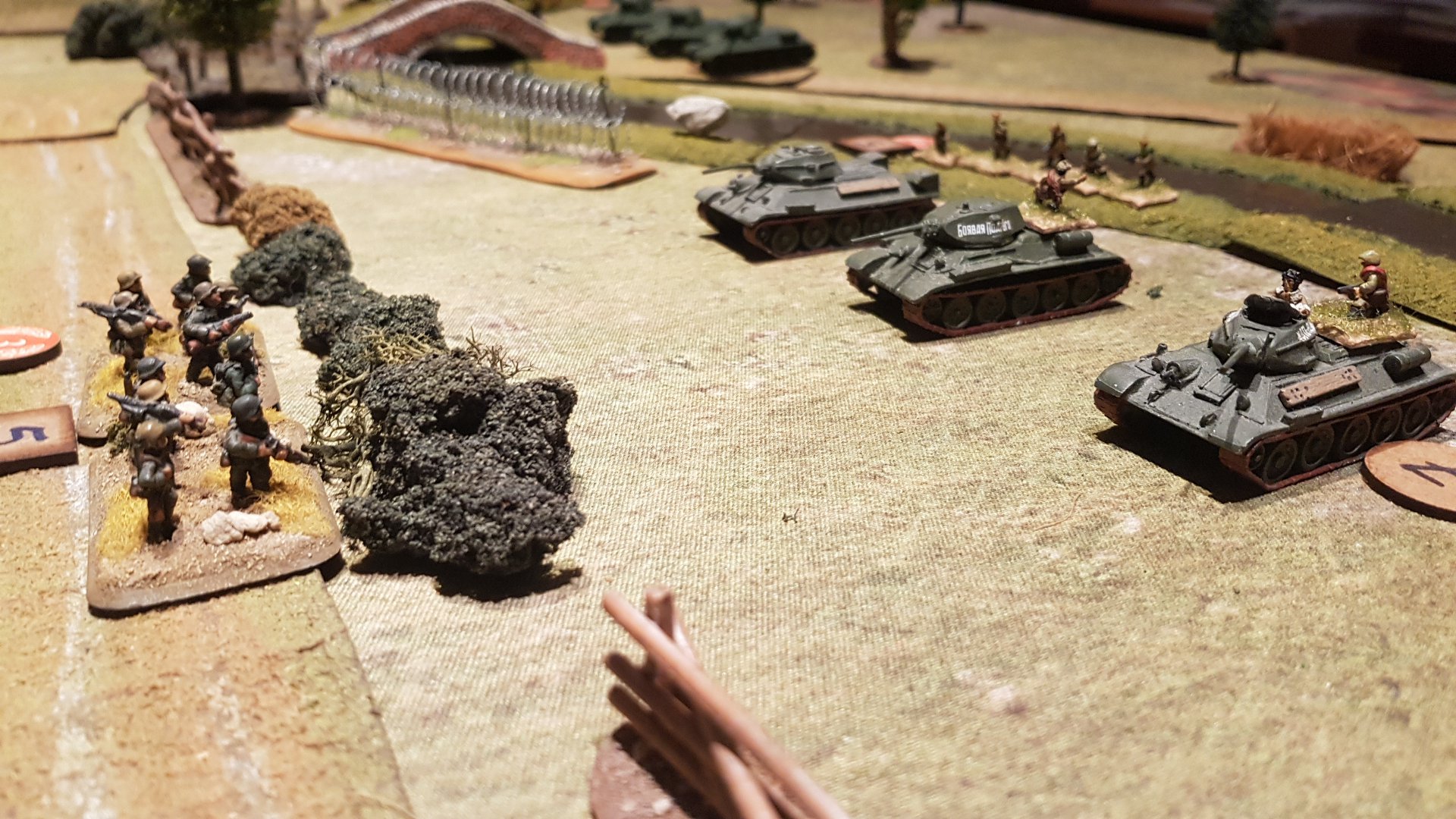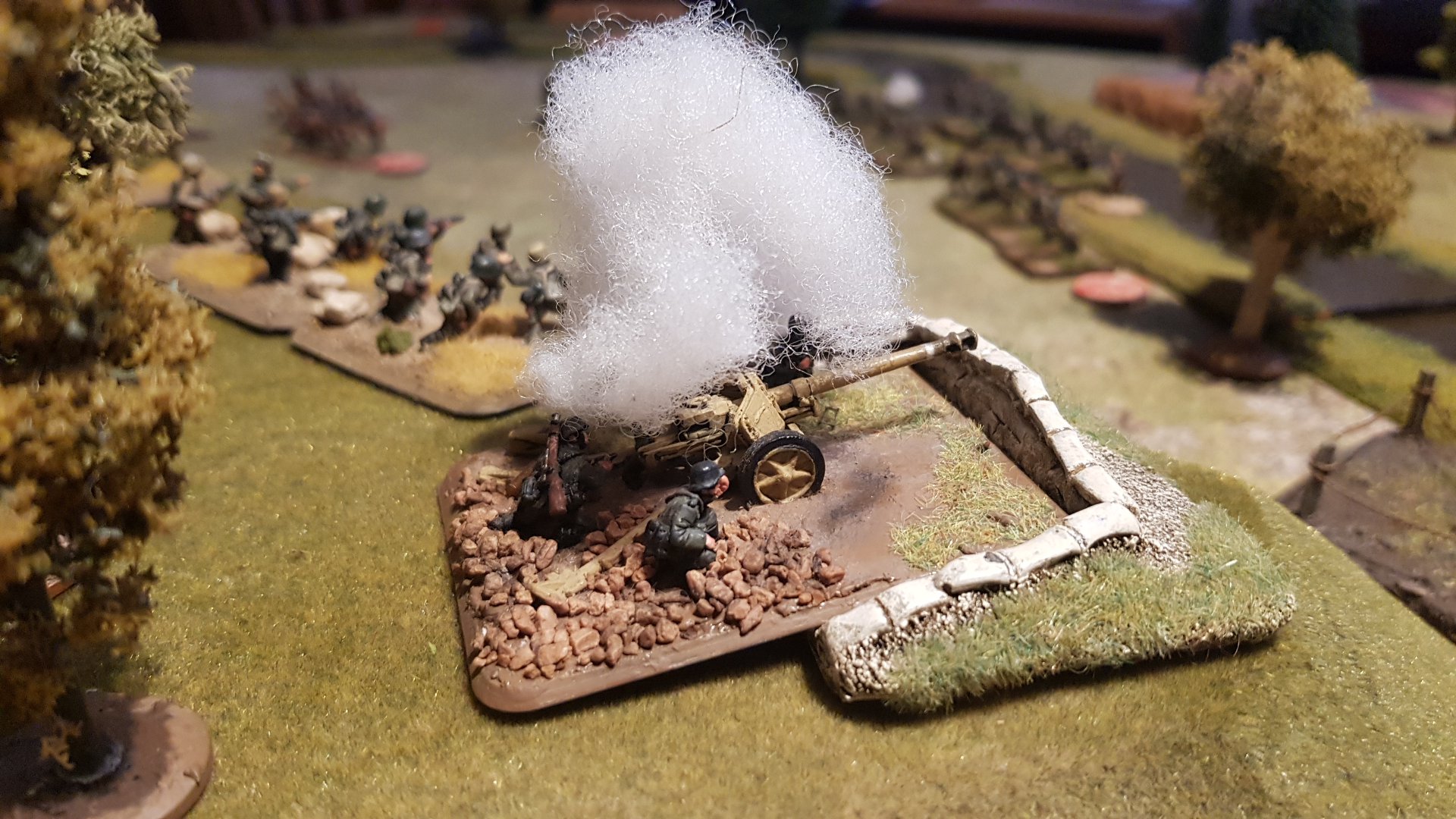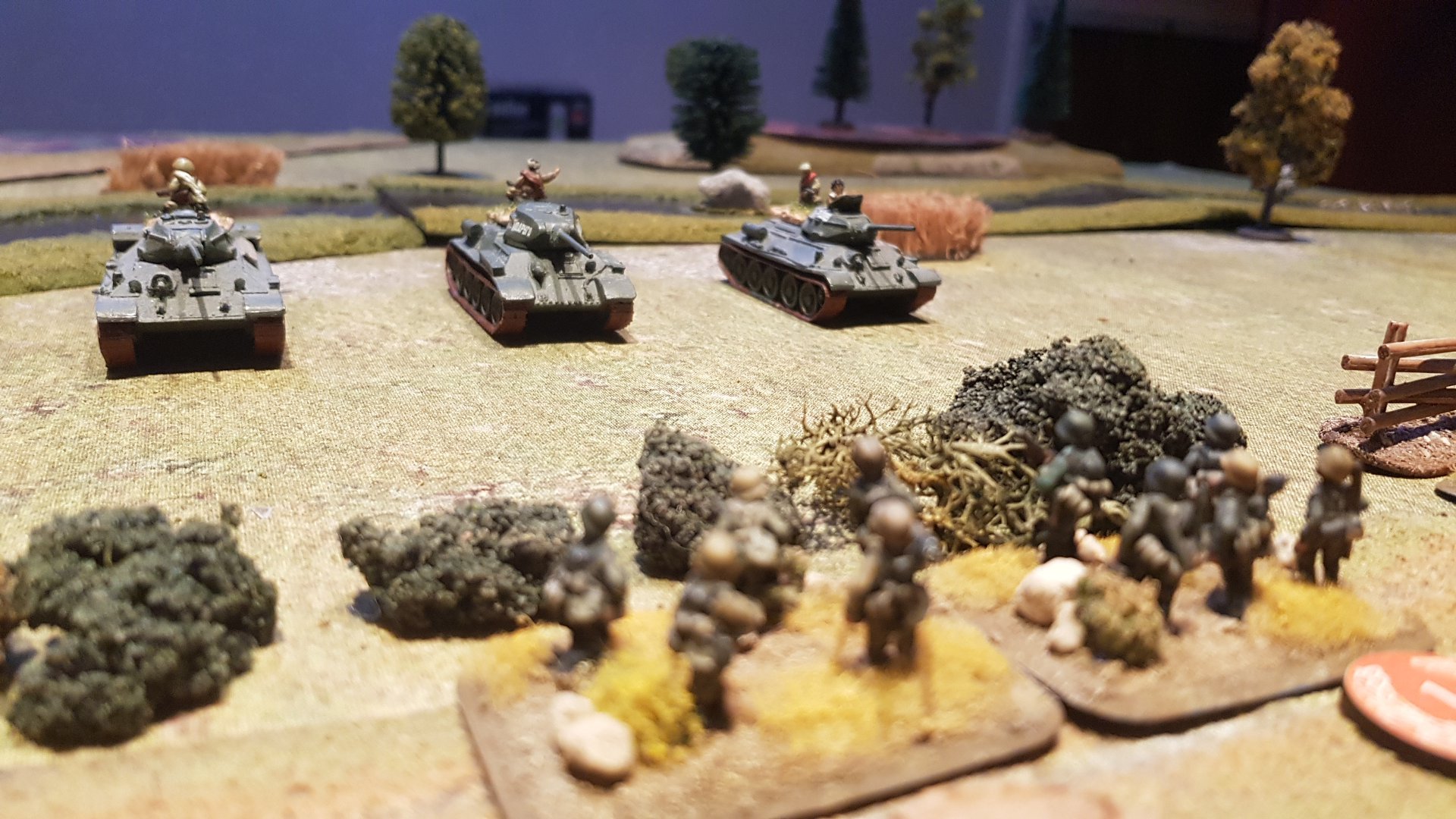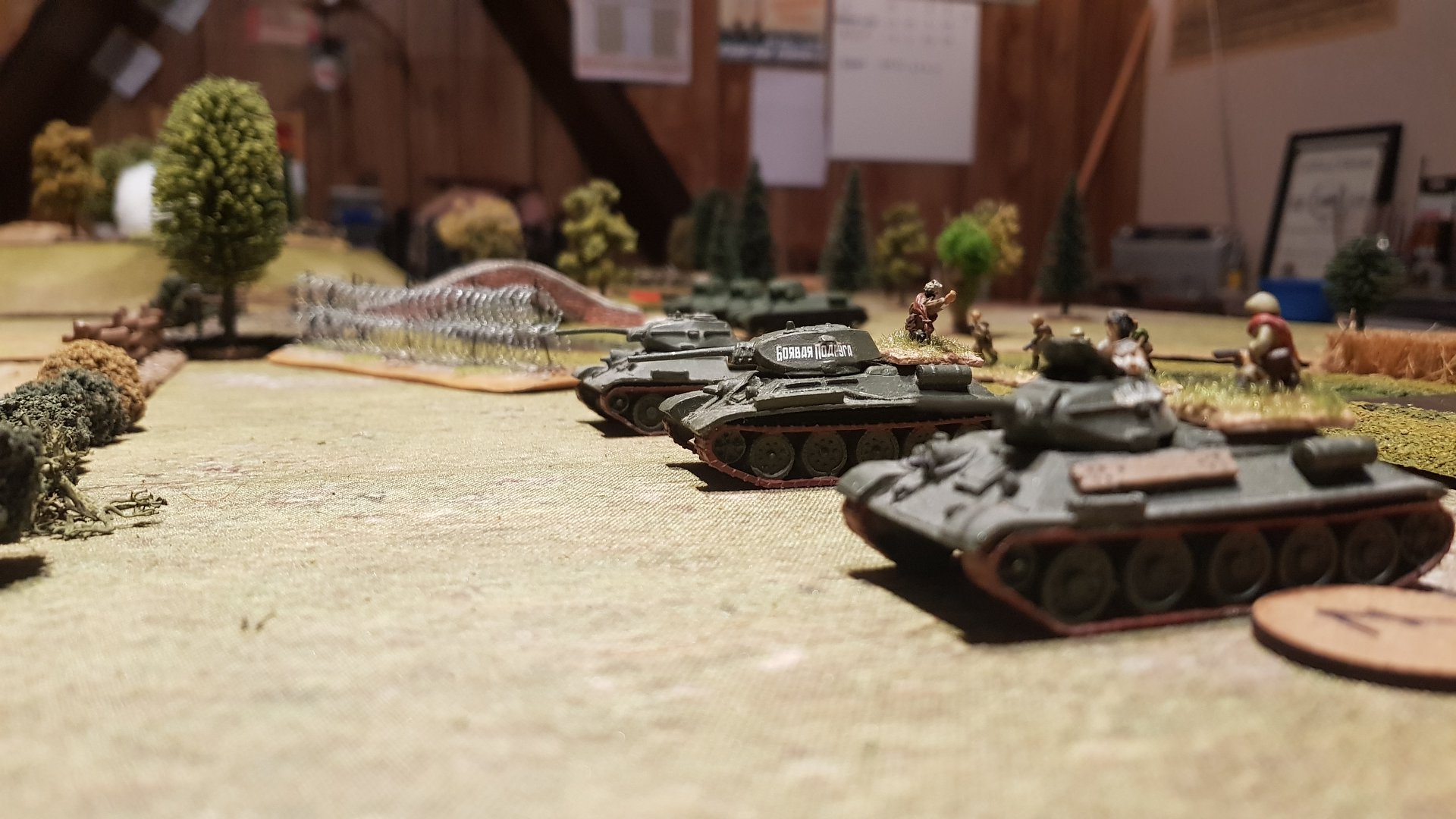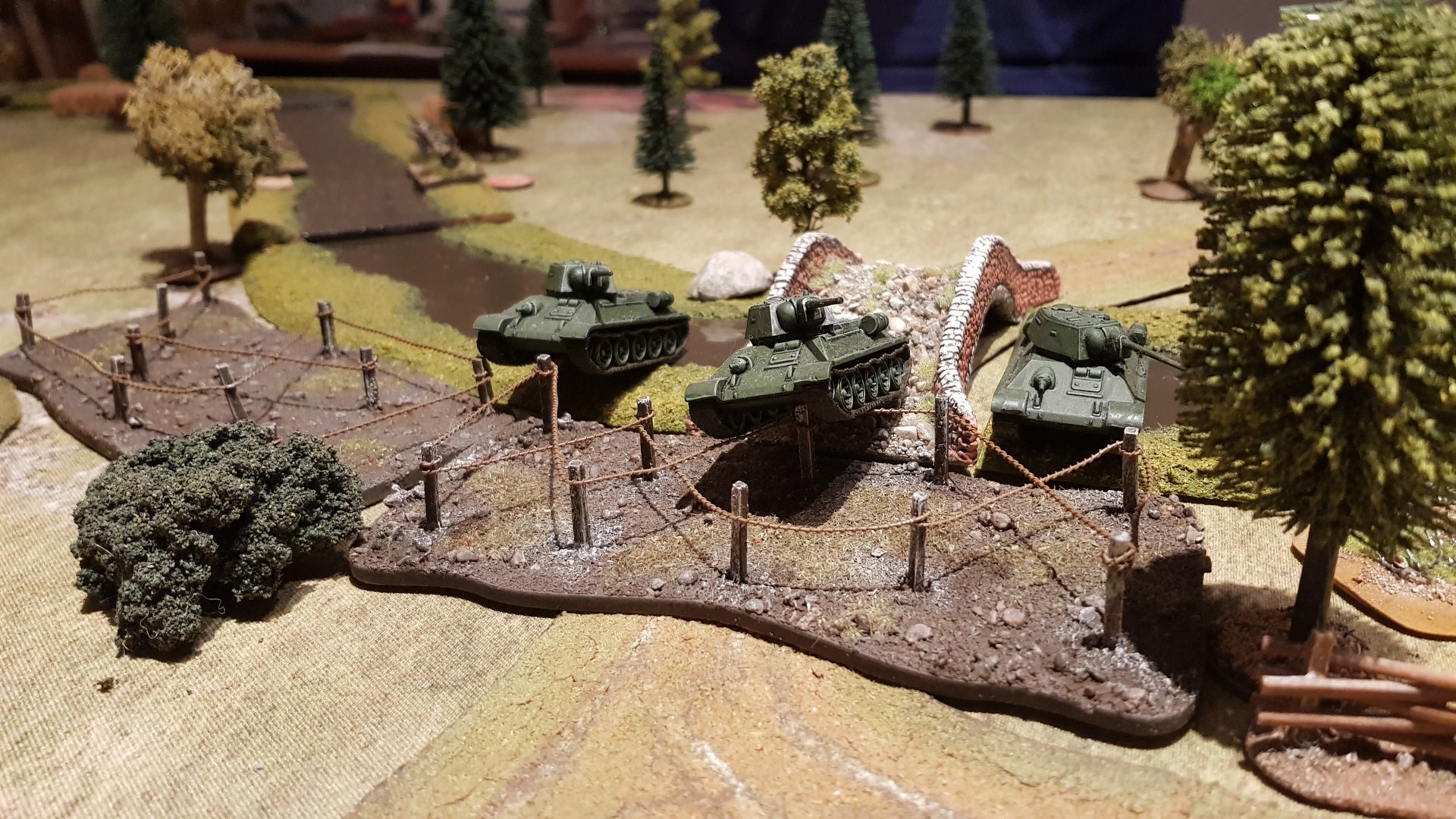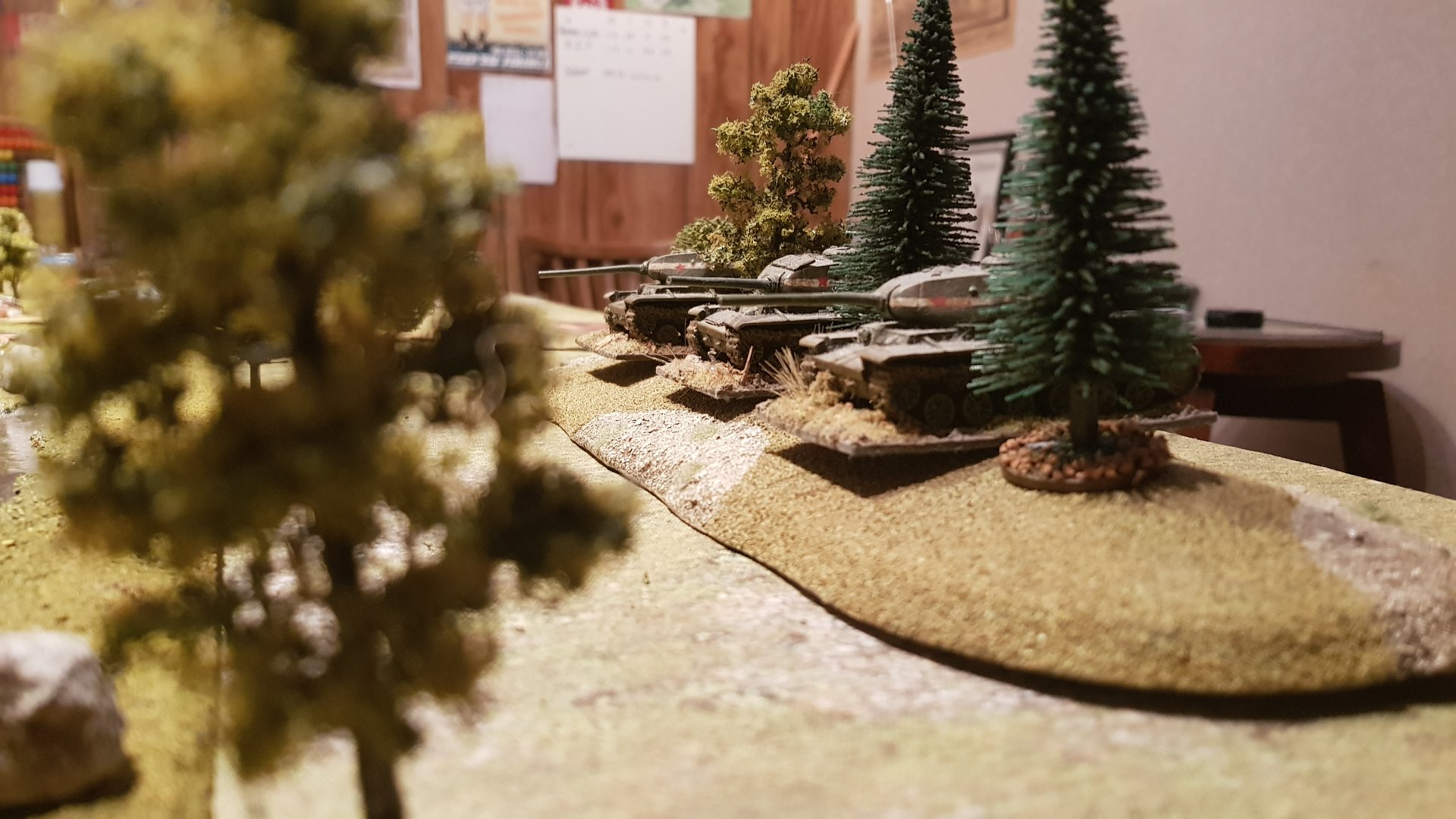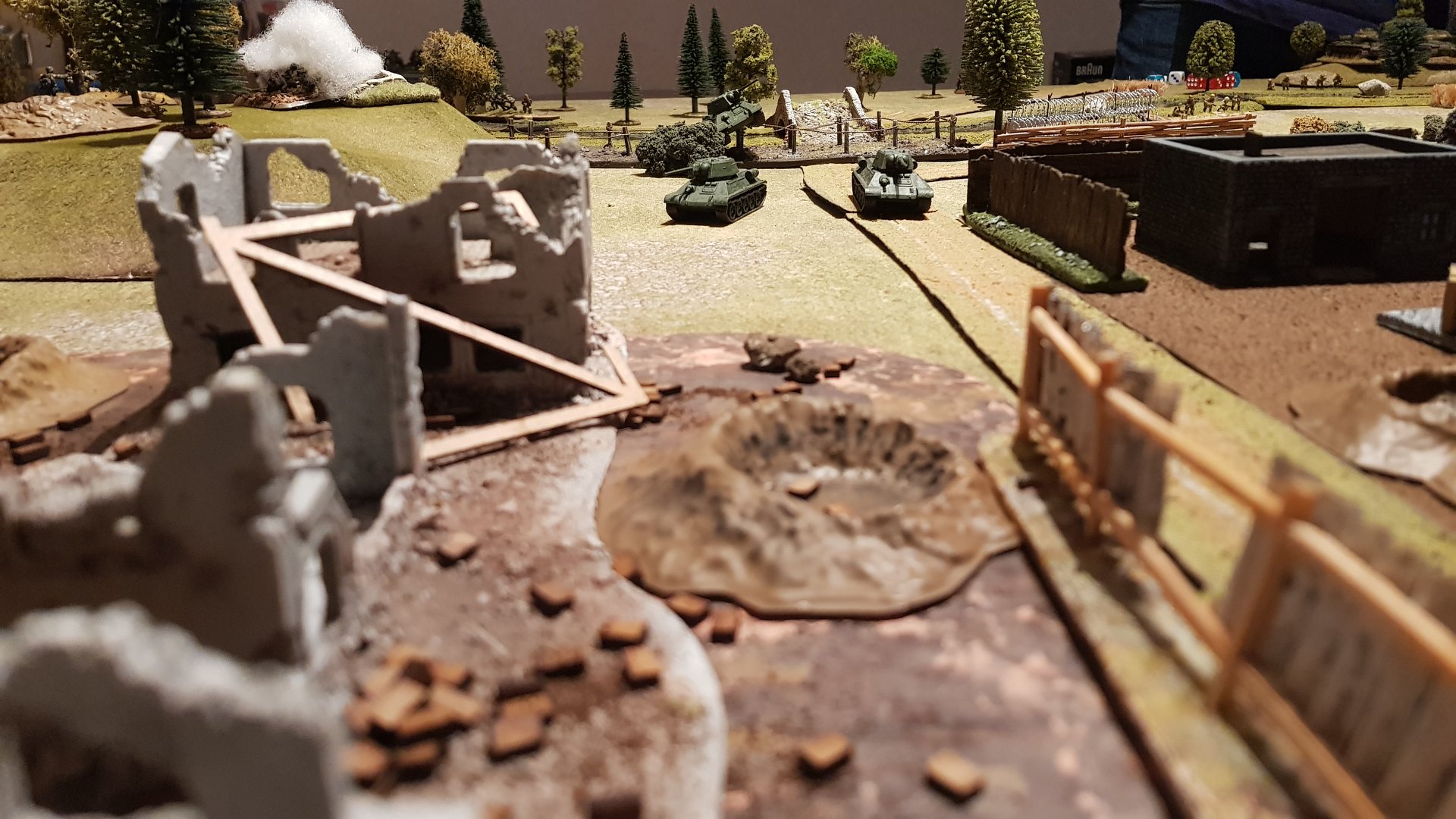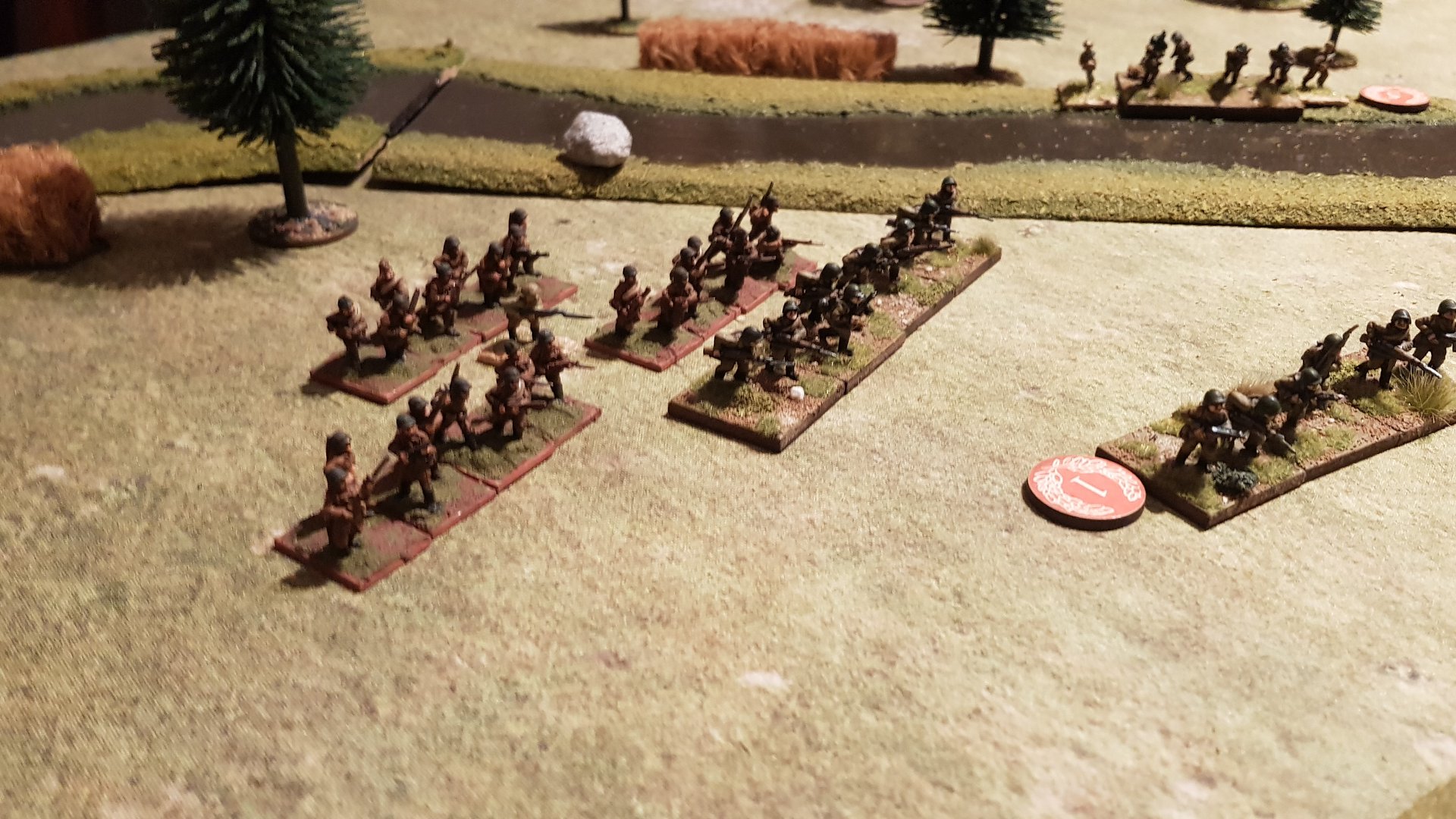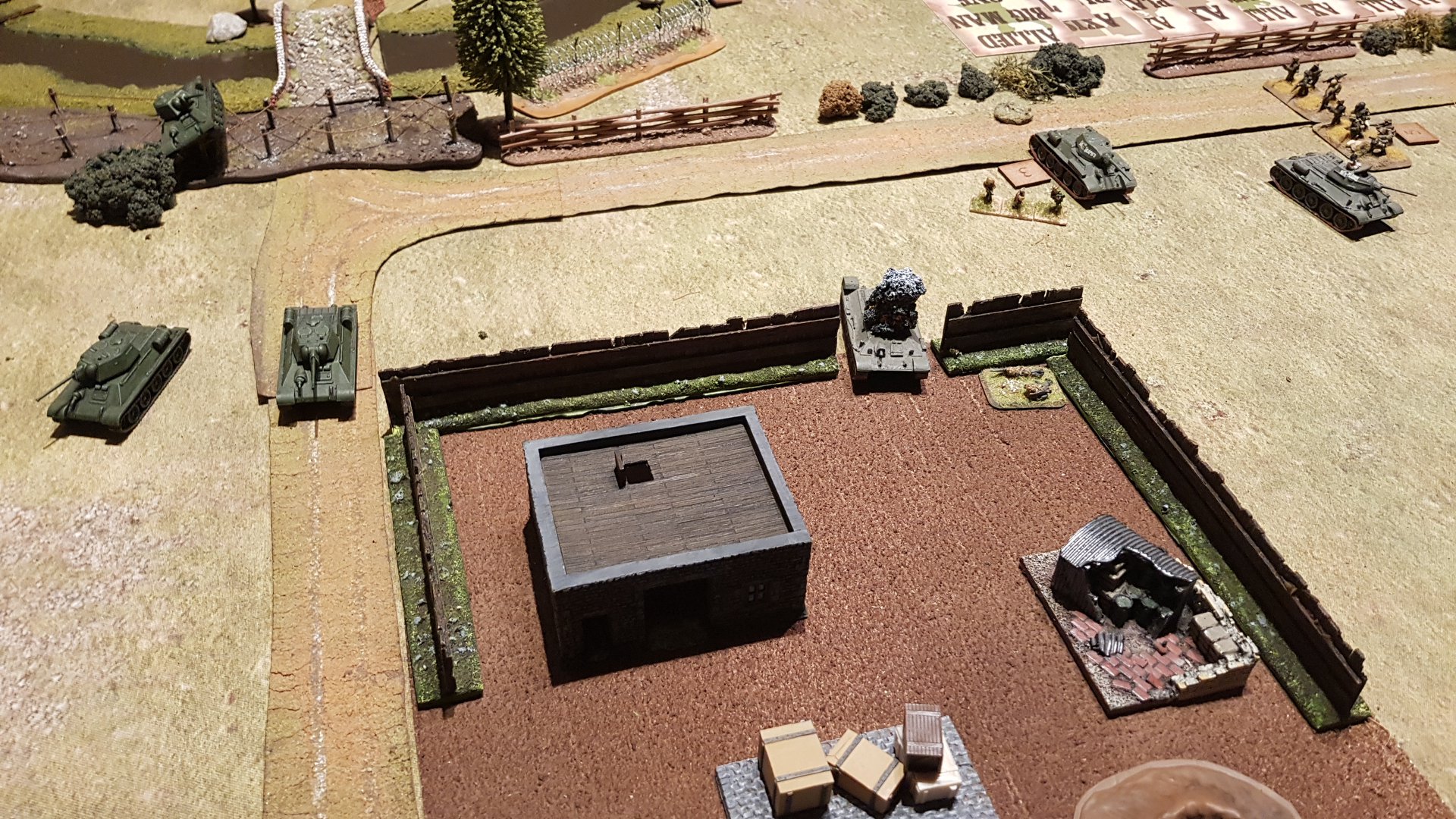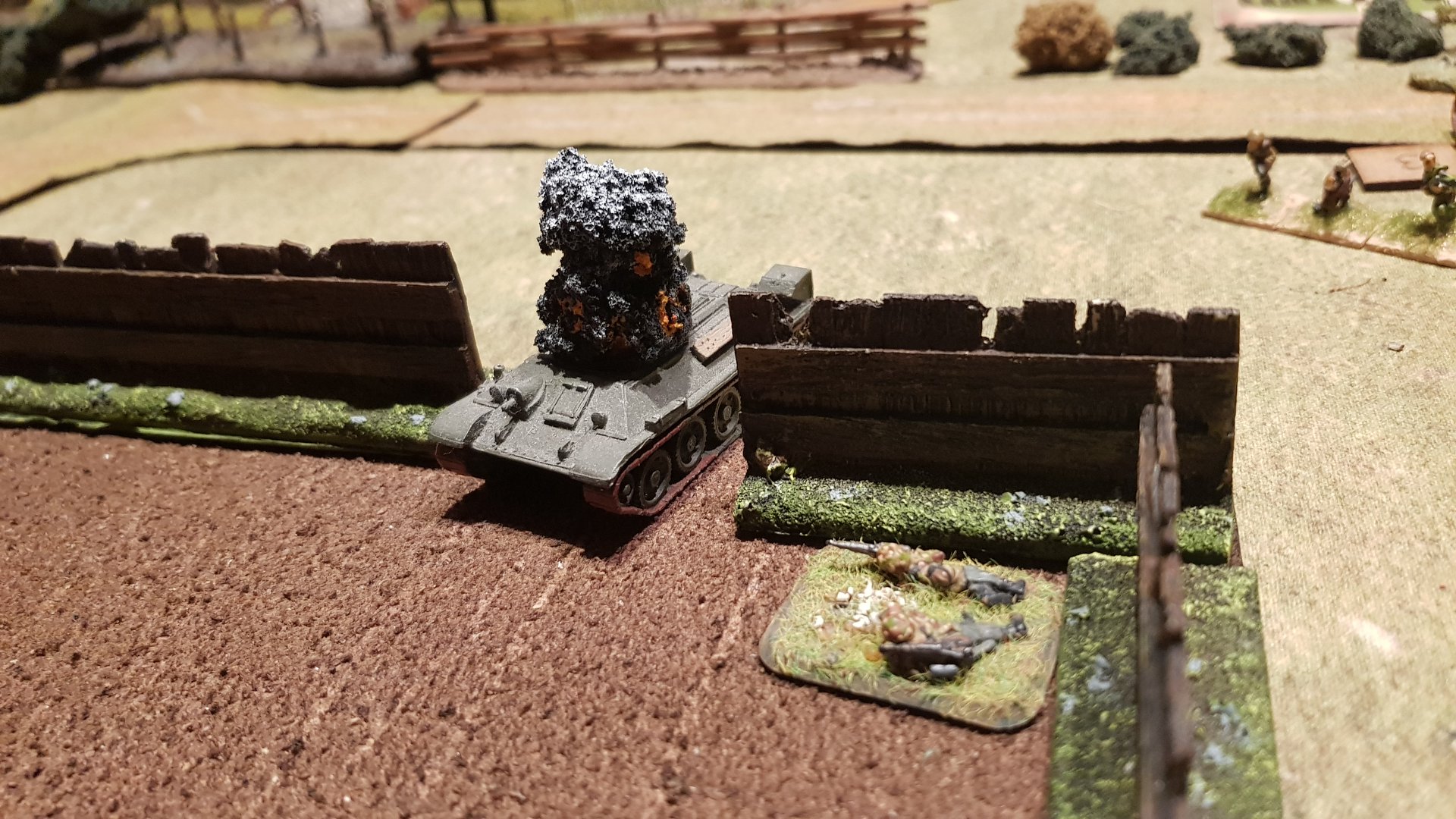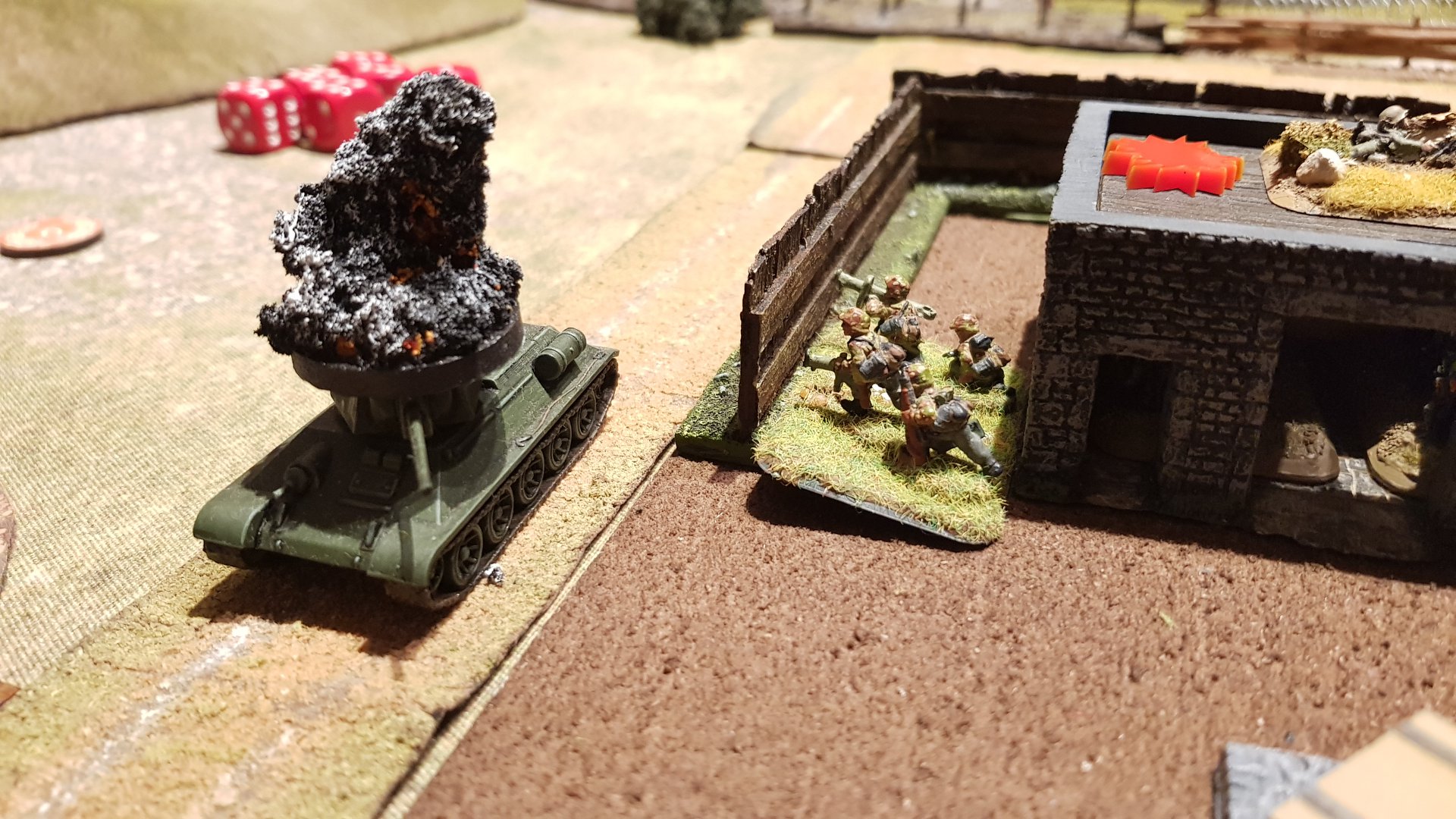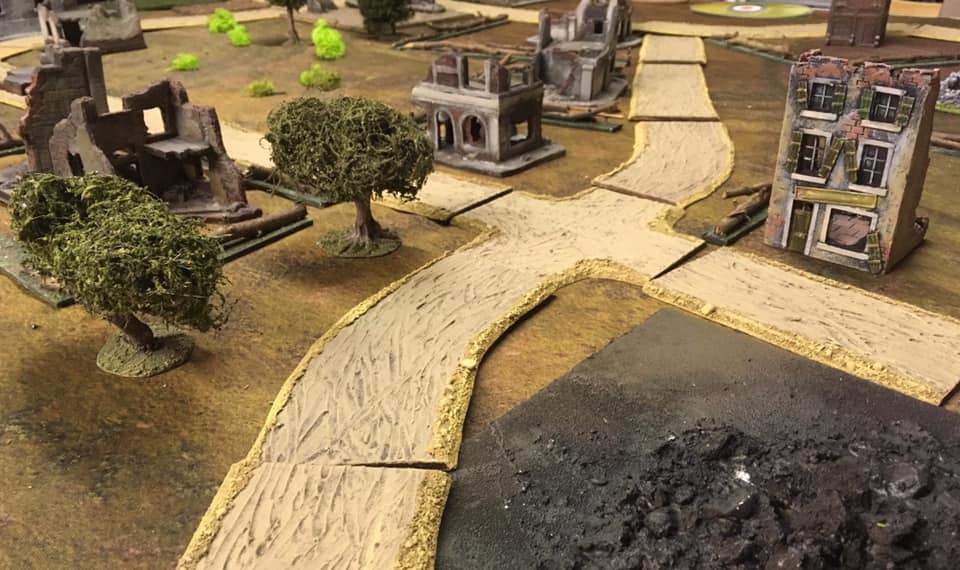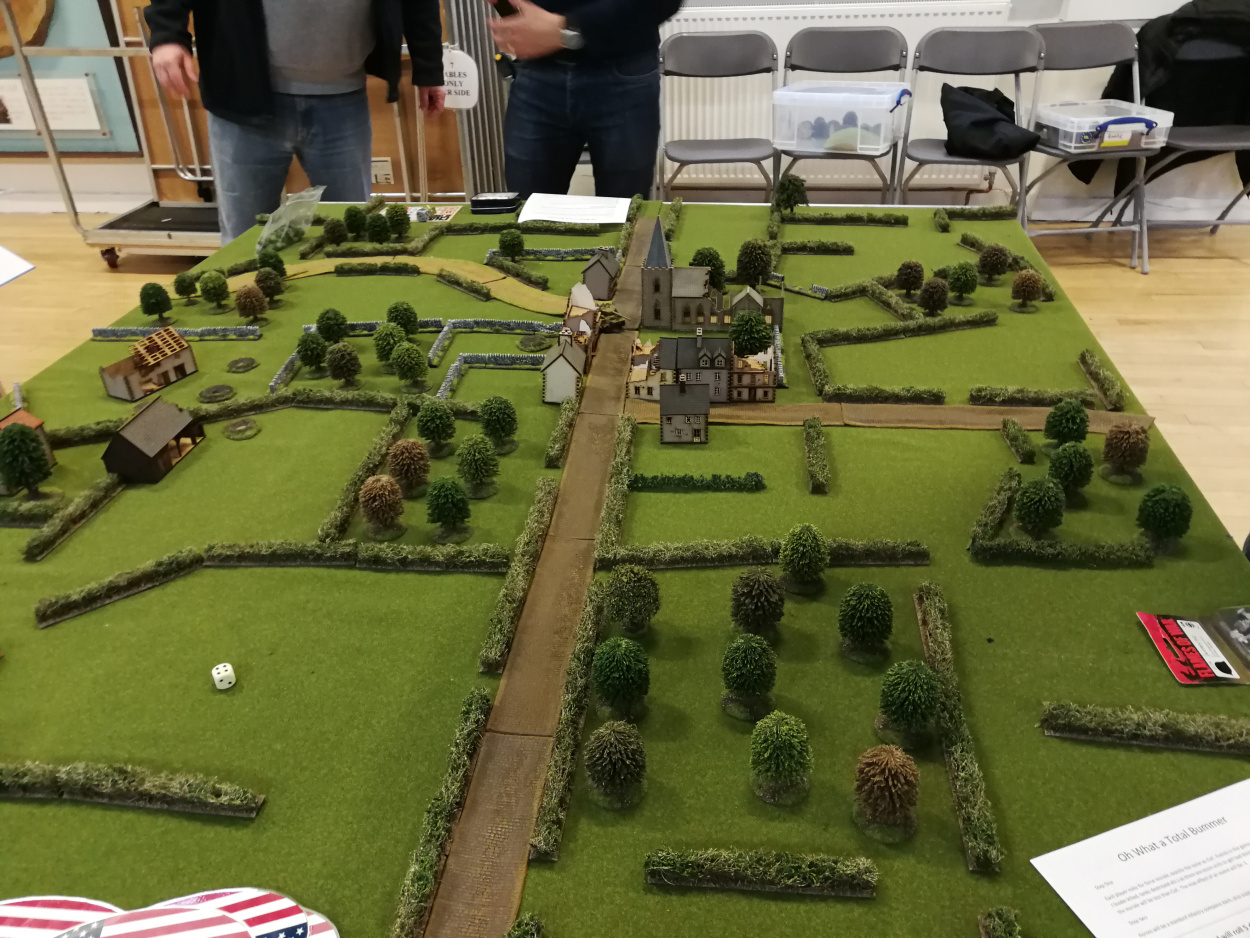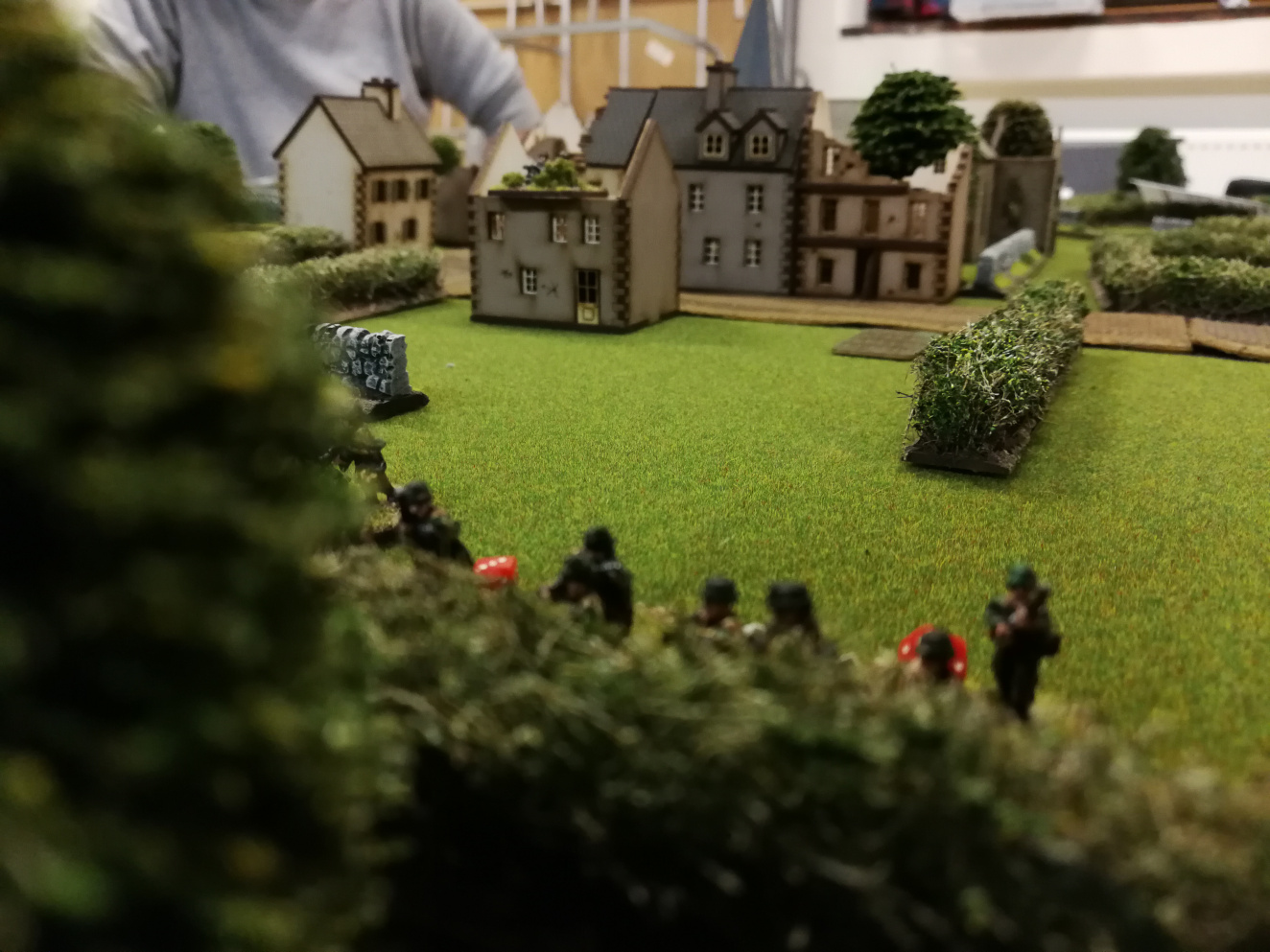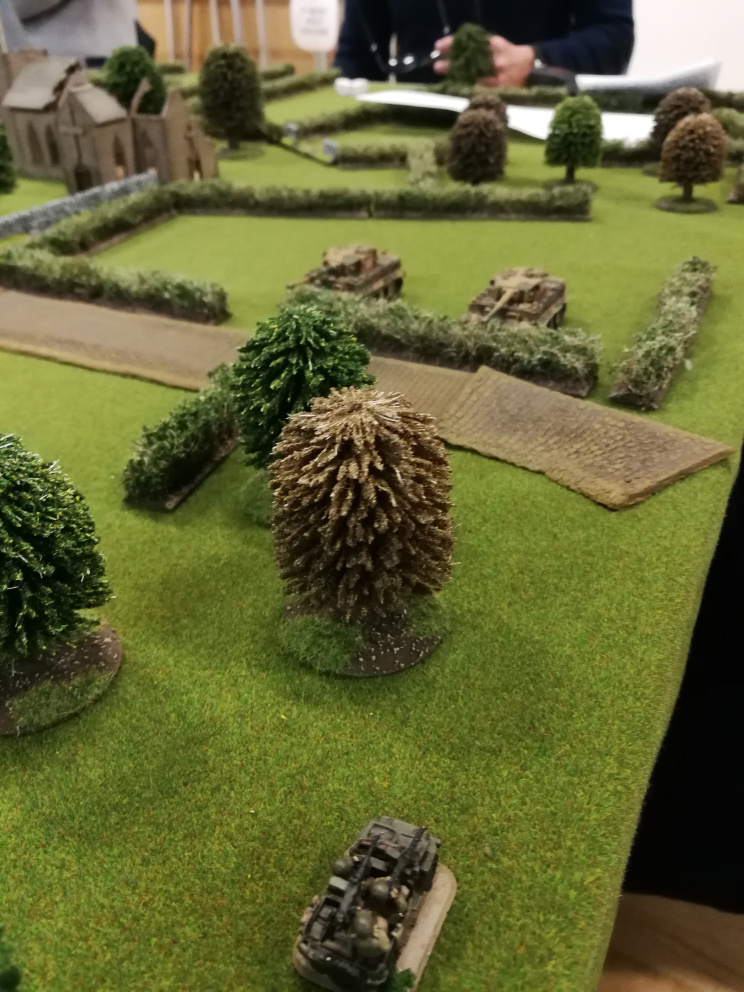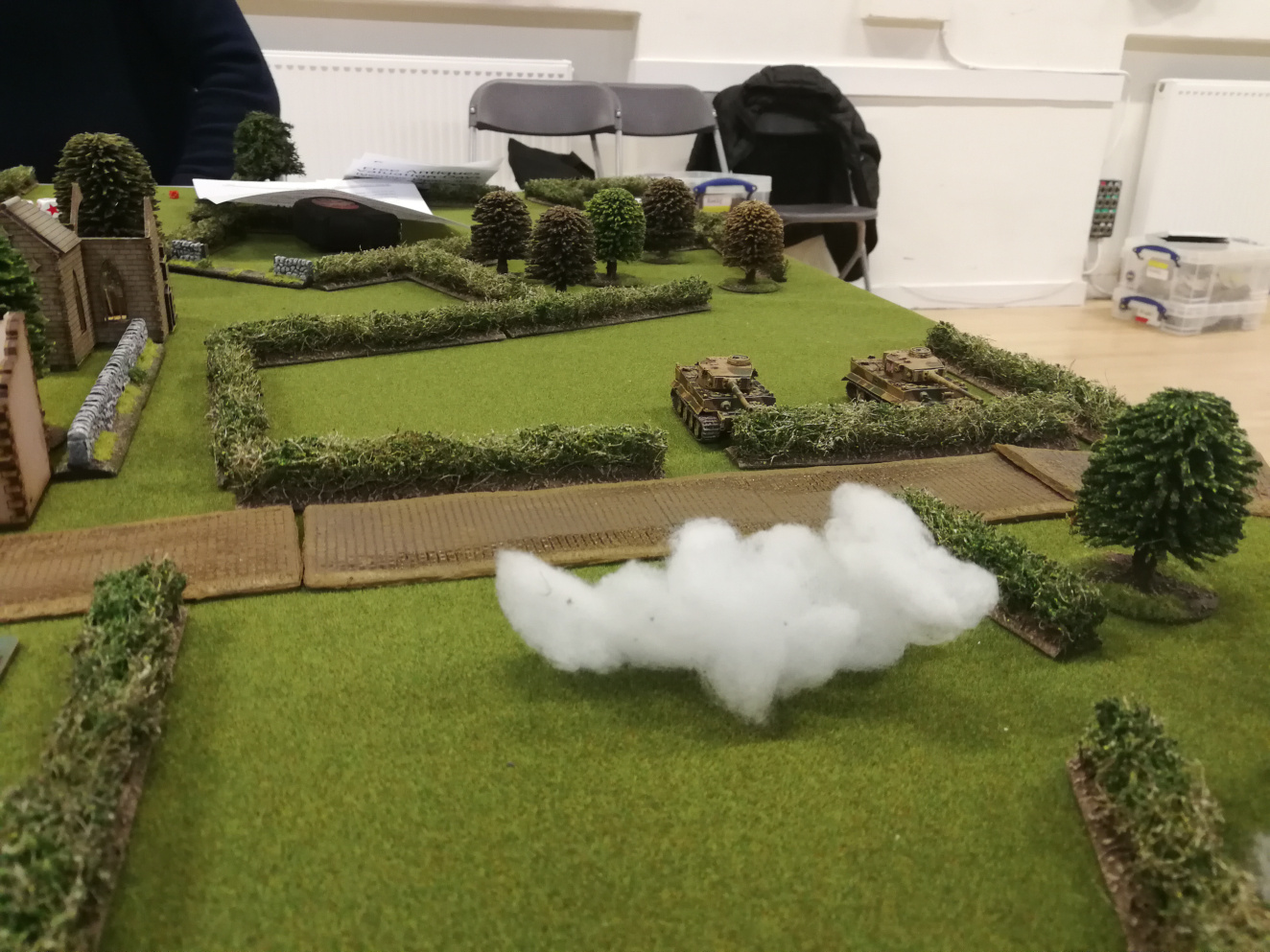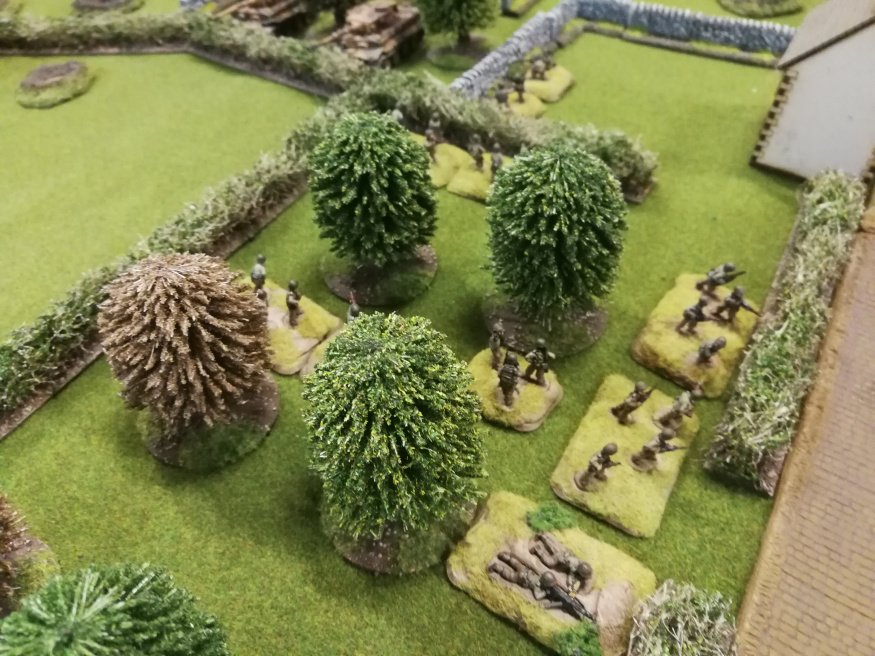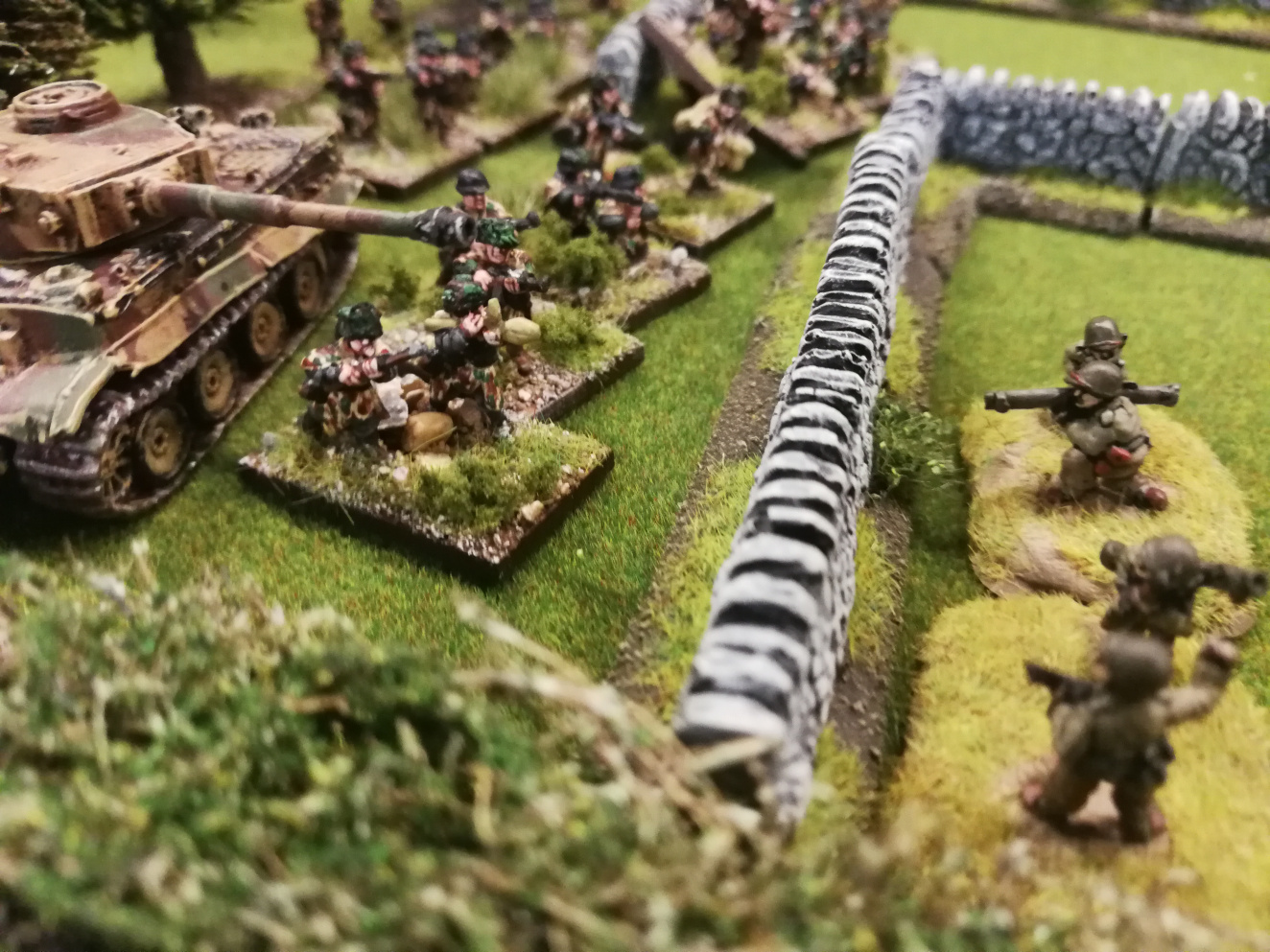In the weeks following the D-Day Boot Camp, I’ve been building an American force and adding to my existing Germans in preparation for a Normandy game I want to put on for my usual group of fellow-minded gamers
My group tend to prefer to play narrative-style games where all the players play one side with the opposition played by an artificial intelligence system, so the choice of which rules to play was important.
I Ain’t Been Shot, Mum, the original Two Fat Lardies WW2 company-based game with its random activations, its Blinds and spotting seemed ideal for the scenario I had in mind. Nothing wrong with FOW rules, but they are more designed for those epic WW2 massed armour games and, well, when you read the scenario you may understand…
The Hamlet of Le Mer(de)
Introduction
It is the night of the 5th of June at what had been a fairly insignificant crossroads in the village of Le Mer, some 5 miles North West of Carentan.
The tows of two gliders from the 101st Airborne, carrying a battery of 57mm Tank Destroyers ( towed 6pdrs to non-American readers), have overshot the drop zone and, being fired upon by AA, have been forced to loose their wards blindly. As it happens, the gliders land on our sleepy little village where, luckily for them, two platoons-worth of the 101st have also dropped nearby, and have started to converge on the sleepy little hamlet.
A platoon of 1058th Grenadier Regiment has been billeted in the village to protect a battery of anti-tank guns whose prime movers have broken down on the way to coast: left behind when the rest of their Company moved on to Carentan.
Neither side knows the other is there…
Background: The Germans
Lieutnant Shutlz stared angrily at the small glass of Cognac sitting on the makeshift table in the warehouse he had made his temporary headquarters in this shitty little hamlet of Le Mer: more aptly it should be called Le Merde, he thought. Famous or infamous for the factory that produced the awful looking bicycles everyone in the area rode.
The Cognac didn’t help his mood, he had risen from the ranks fighting in Russia and had never developed the taste for the stuff that his fellow officers had , it was only marginally better than the swill they called wine here. He was from Bavaria, now a good Bavarian Dunkel beer and you were talking. The Cognac’s only saving grace was it was alcoholic and you could get pissed quickly on it!
Why did he need to get pissed ?
His bloody Company Commander had left his platoon here to guard two shitty guns and their crews whose tow trucks had broken down. They’d all carried on to Carentan to deploy for the damn Allied Invasion!
Personally he didn’t know what the fuss was about: they could have France, bloody hole; they could keep Russia too. Why any self respecting German ever wanted to leave Bavaria, never mind Germany, eluded him!
To cap matters Private Dingler, or Private’s Dingler ,as he was always running off to take a leak, had run in from one of his 20 minute forays outside, (for a fag he’d said but the platoon knew better) had panickly shouted that he had a loud crash in the field to the wet of the Village, ‘Loud Crash’ he thought how anyone could hear anything over the noise of passing Allied Bombers , and the booms from their falling bombs!
To make matters worse he’d tried to contact Company HQ earlier in the night and found the Radio was on the Fritz ……again!!!!!
Probably a waste of time but he’d better deploy the platoon just in case, which was sure to increase his popularity with Sgt Muller!
Background: The Americans
SHIT SHIT SHIT SHITTY SHIT! was the 1st words that came to the mind of Sgt Dingler 101st Airborne. The only bright spot was the fact the two gliders bringing in his battery of 57mm guns had landed fairly safely, despite being released and abandoned by the bloody air Corp when they’d had a few flak guns shoot at them! Fairly being the term as the Lieut had been the only casualty, knocked unconscious on the ‘landing’.
So he was in command!!!!
He’d got the guns out of the Gliders and one of his gunners head off to reconitre the village he’d seen by a few window lights to the east of where they had landed, he guessed someone may have spotted or heard them crash!!!!
The only redeeming thing so far was another of his gunners had made contact with a couple of Riflemen from the 501st, who were part of a mixed platoon of guys coming in from the east of their position.
Willy Summers’ Platoon.
Lt. William ‘Willy’ Summers nervously crouched at the gap in the huge hedge, that led from the field he had crossed, on his way to the the village he had spotted on his way down, before he became entangled with the tree. There had only been one on the edge of another field , and no matter how he tried to manoeuvre somehow he had landed at the top. 20 minutes of quiet cursing frantic cutting, and not a few cuts and bruises had got him to the bottom, where he found 10 of his men from his stick, standing and crouching amusingly watching his predicament.
Finding as much dignity as he could muster he had them through various more fields picking up various troopers from just about every company of the 501st and even a couple of 82nd Airborne, he wouldn’t be totally surprised if there were not some Limey Paratroopers in the mix, though he had collected a mortar crew.
One of his scouts had found an opening on to a dirt track road, which he now intended to use to take the village ahead. He signed his makeshift squad leaders to spread their squads on each side of the track, and hugging the hedgerow they would advance towards what looked like a bombed out building on the edge of the village.
Preparation
The first half of the evening was spent sorting out the activation cards for the two sides. The Americans, being Elite, got a Rapid Deployment card which gives them an extra four dice of activation for moving when under a Blind. Two Tea Break cards were added , so initially the pack would consist of just five cards: a Blinds activation for each side, and the above two cards.
The initial part of the game is set at night so all spotting distances were halved.
For those not familiar, IABSM uses Blinds for units not yet spotted with at least one extra Blind to add the fog of war - it’s meant to represent a couple of scouts who are assumed to melt away if spotted.
The possible German units available were each given a playing card identifier, and an identical card was placed in a reinforcement pack. More cards were added of different suits, representing “non-units”. This pack was shuffled and a number of cards were drawn and assigned Blinds. We therefore had no real idea what German forces were in the village: if a “non-unit” card was drawn, its Blind would be removed on being spotted.
To add to the fog of war, rather than putting German Blinds down onto the table at the start of the game, we just put down four “zones of deployment”, and when it seemed appropriate, we would randomly deploy a German Blind a random direction and distance (a D6+4 inches) from the deployment zone marker, then place the Blind as close to available cover as possible.
The First Night’s Move
We then played out the first night’s moves…but nothing particularly exciting happened in these moves as units moved on Blinds, though there was a very cinematic feeling to the various units blundering around with no idea where the opposition was.
The American AT gun Blinds split: one headed for the hedgerows by the one road; the other, which was sitting a bit exposed , pulled their guns into the broken ground to the north of them, hopefully to get a firing position on the road coming from that direction.
Heading for the hedgerows
Occupying broken ground
The infantry platoon on the right (west) moved towards the road but sent a scout Blind to check out the group of buildings to the north of their position:
The platoon to east (Summers’ platoon) moved very slowly (bad dice roles) down the hedgerows each side of the road until it reached the crossroads, directing one squad into a ruined farmhouse:
The Germans sent out Blinds to the three buildings being investigated by the American scouts: two into the four storey building to the north of town and others to the building around the northern most crossroads. Others were deployed to the other four storey building, and two headed for the ruin that Summers was heading for.
The Blinds that were left were deployed either side of road from the German deployment zone placed on the southern entrance to the table.
Lots of failed spotting roles were made as evening went on, and only as we were about to call it a night was anything spotted: unfortunately for Lt Shultz he was spotted directing troops.
3rd Grenadier squad was also spotted, lurking near the base of a building, by eagle-eyed American gunners.
The Second Night’s Play
At the end of the first night’s play, Lt Shultz had been spotted standing in the middle of the road directing his troops around the village. Most had made it into good positions (we think) apart from 4th Squad that had been moving towards the four storey building nearest to him.
Lt Summers had sent his 3rd Squad into the bombed out farmhouse, but they they had spent the whole move getting to the first floor (second floor to U.S readers). We had originally just decided to take that squad off Blinds but in the break realised the whole platoon on the Blind had to be revealed. Likewise we realised that all of Lt Shultz’s platoon needed to be taken off Blinds, so we rolled for where they were: finding 2nd Squad at the far end of the Southern road by the bombed out Mansion. 3rd Squad had been one of cards pulled out in initially set up , so would have to randomly arrive as reinforcements on start of subsequent moves.
This decision turned out to be a wise one as the now revealed 1st Squad lurking behind the hedges directed them to Lt Shultz, and with a very easy spotting role (it’s still night) they opened fire on what was an easy target.
Lt Shultz must have had good hearing, and heard weapons being cocked, as he dived to the ground as his two aides were turned into pink mist by the volley of shots by 4th Squad.
It didn’t help him much, as two troopers from 1st Squad promptly crept round the edge of the hedge and let him have it. Despite trying to use the bodies round him for cover he developed two new body cavities and decided to retire from the game.
All the German Blinds tried to spot where the firing came from, and the German squad finding themselves standing in the road when a whole pile of gunfire started dived into the ground floor of the nearest building (although for game purposes they were stuck on the roof).
1st German squad on roof, figures at base are 2x Panzershrek teams taken off Blinds later
The German 2nd Squad at far end of table hearing the same shooting , dropped into the hedge line and started to make their way down to the crossroads.
2nd German Squad carefully moving back to village.
Then for what seemed to be a theme for the night, the second Tea Break card came out ending the move before the American Blind card came out, leaving the un-spotted anti-tank gunners and the 1st U.S Para platoon un-moved.
At the start of the second turn, it was decided to pull all the German units on table off Blinds, to ease play.
Having already deployed one German infantry zug, we needed to draw three cards for their reinforcements, and managed to pull out 3rd Squad; the armoured car unit of the Panzer Lehr; and a unit of old French tanks that were being used by the local German forces: a Somua and three Hotchkiss H35’s or Renault R35’s (I’ve forgotten which).
Then, working from the most likely Blinds already on the table to the most unlikely, we drew cards to reveal if it was a blank or real unit. This revealed that the two Panzershrek teams were in the lower floor of the building shown above; one of the Pak 40’s was in the lowest floor of the other four storey building ; and finally that one MG-42 MMG team was in the rough ground right in front on Para 4th Squad covering the road to the east.
The other MG-42 MMG team was in the one of the outlying hovels at the north west side of the table.
And finally the last PaK 40 was stuck by the ruined mansion at the the most southerly end of the table. Strangely enough its deployment and that of the German 2nd Squad fitted the original narrative in that was close to the road where it’s towing vehicle had broken down and the squad had been deployed nearby to protect it.
Despite all above being put on table, the next series of spotting roles led to a lot of confused troops as after the first flurry of gun fire any unit and the subsequent scrambles for safety, everyone had lost sight of each other.
The 6th Para Squad had moved to cross hedge and enter the ruined farmhouse, but had got stuck in the hedgerow and only just managed to get into the gap between the hedge and the farmhouse.
And before the US Blinds card came out we had the second Tea Break card…so despite their no show for last two moves the Para anti-tank guns and the 1st platoon of Paras were left on Blinds. The fog of war!
At this point we decided to role to see if dawn was breaking, but night was firmly entrenched.
We also rolled for reinforcements and the 3rd German Squad appeared on the northern edge of the table: gingerly making their way back after having stopped off at a local tavern
Summers’ platoon then sorted itself out with 6th Squad finally managing to move into the ground (US: first) floor of the ruins.
It was obviously a dark night because nobody could spot the MG-42 team in the broken ground, and they must have still been looking down the road as they spotted nothing either!
The German Panzershrek teams moved to either end of the building they were in, and the totally forgotten Sgt Mueller who was their commander ( and now to his horror platoon commander) was located where he was hiding with the first PaK 40 in the four storey building (he can be seen at top of building in photo above).
And, of course, the US Blinds card didn’t come out before the second Tea Break card came out again! We therefore left the unrevealed American units on their Blinds: they do get an extra activation dice on Blinds…if you ever get to use it!
We then rolled for the night again, but dawn had still not broken.
And Germans got more reinforcements: three Panzer Lehr armoured cars (Sdkfz 222’s) who randomly appeared on the western road leading into Le Mer right behind the Blind concealing the second half of the US anti tank guns. This could get interesting and a lot would depend on whose card would appear first.
Meanwhile, the German 2nd Squad was still slowly moving down the hedgerow and this continued.
Then the US 5th and 6th Squads failed to spot the German MMG and vice versa.
Then the US Blinds card was drawn: hurrah!
This quickly prompted a’ discussion’: Pete wanted to make the guns fire twice at the armoured cars, but I thought about this: the guns had still been effectively moving forward, and had not been unlimbered for action, so we used one activation dice for them to spot, one to unlimber and only allowed one for the shot. According to the rules, the first shot should be aimed, but we argued against that…despite which it hit the lead vehicle and disabled the armoured car: knocking out the engine and stunning the crew (two Shock) for two activations.
Meanwhile 1st Platoon dived into the hedgerow and moved up towards the crossroads on hearing the commotion behind them; and Sergeant Mueller dived over to the other side of the building and saw nothing.
The forgotten MMG team in the hamlet saw nothing .
The Panzershrek teams heard a bang but saw nothing!
The second armoured car (which had survived the anti-tank gun’s opening volley due to the ruling above) hadn’t spotted the gun which had taken out their colleagues, so decided to carefully move up behind their suddenly stopped lead vehicle, with the commander propping himself on top of the hull to peer over the hedgerow to see if he could spot anything. He didnt!
At this point it was 10 o’clock and Zeberdee called time for bed.
Game Session Three
We drew or daylight and finally the faint glimmer of early morning light began to dawn which we decided would drop spotting roles but only -2 as opposed to -3 and drop the multiplier for spotting.
We left it with the one of the anti tank guns having just disabled the lead SdKfz 222 on the road which came into Le Mer from the west; with the commander of the second armoured car standing on top of his car peering over the top to see what the hell had shot his comrade. As it happened, he was about to find out: one of the first unit cards drawn was for one of the anti tanks guns. Pete wanted to immediately fire at the disabled armoured car, but it had a stunned crew for at least another move and had he fired, the gun would have been a sitting duck for the other two armoured cars who could then safely scream round the corner and let them have it. So Pete reserved the gun’s activation, effectively putting it on over watch.
Meanwhile, leaving the warehouse building by the northern road they had come on, Squad 3 moved forward along the hedge and the 1st U.S Para platoon moved along the hedge on the western road, then crossed the hedge and took up positions around the western corner of the cross roads.
All the other units continued to try and spot what was going on, but the only success was Sgt Hawkeye in 2nd Platoon (the platoon’s other Big Man) who thought he saw movement in the rough ground in front of their bombed out farmhouse and spotted the MG-42 position. 1st Platoon’s card had already come out, but 3rd Squad had held back its action and opened fire on the hapless machine gun, and despite very lousy chances took out both its loader and commander.
The second Tea Break card came out, and the rules allow un-activated units to fire if they have a target at Close Range, so the reserved AT gun did, putting three shots into the hapless lead armoured car…but only blowing it up on the third shot: the first two just put more holes in the engine.
The end result was a spectacular explosion which pretty much buggered everyone in the immediate area’s night vision
On the next move the only thing that happened was the lone gunner left on the MG-42 returned fire taking out one of the paras (we were having a good set of die roles: he was on a reduced chance as a lone gunner) and the second AT gun on the western road deployed with the other gun to watch the armoured cars. It also got a bit brighter.
With the new move the first card out was for the second US platoon, who’s third squad promptly let the lone MG-42 gunner have it. This drew the first German squad’s attention, who moved from one side of the building they were in to the other to see what the hell had been shooting.
As it happened, one of the Panzershrek gunners in the floor below was able to tell them where it came from.
Likewise the second squad, on hearing gun fire to their front, moved off road to the shadowy building on hill to their right.
Everyone then had tea again.
As dawn was about to come down with a crash, Summers’ platoon could hear the sound of tanks and could see coming down the east road what looked like a column of tanks ( I had got another German reinforcement role: I needed a 6 , and four commandeered French tanks in German service arrived…a Somua and three Renault R-35’s).
To say both units sides were surprised was an understatement. Summers’ 2nd Platoon’s 1st Squad dived into the hedgerow, the bazooka team took up position on the crossroads, and the mortar crew stood amazed and told Summers ‘Tanks’ ! This was perhaps not their wisest decision. The tanks came to a screaming halt with their commander spotting the hapless mortar crew and diving into the turret and shutting the lid. There had been a discussion about unbuttoned or buttoned ( you could see the glint in Pete’s eyes about shooting the commanders or even his famous “mortar through hatch”, but I had been reading about British tanks moving at night, and if the Germans took the same practice only the lead tank would be unbuttoned, the rest would would just follow the light in front, a practice even more likely with all the gunfire). Then we got two more Tea Break cards again, and moved on to the next turn.
As it happened, the next move was pretty much the German response move. The tanks’ card came out first: the lead tank opened fire and killed one of the mortar gunners and Pinned the rest. Two of the others took up position either side of the road and machine gunned the the hapless mortar crew, putting more suppression on them. The mortar crew, in desperation, fired a smoke round to obscure their position. The fourth tank moved cautiously through the gap in the hedge row to get a flanking position on the farmhouse.
The third German squad had by now spotted the US anti-tank guns covering the southern road and opened fire on them, killing one of the crew, who returned fire and managed to annoy one of the local pigeon population.
The second German Squad opened fire on the farmhouse, putting suppressive fire onto their opposite number in Summers’ second platoon.
First German Squad opened fire on the farmhouse, putting supressive fire down on their opposite numbers in Summers’ 2nd Platoon; and 2nd Squad, having found there were no windows on the northern side of the barn they were in, decided to join the tanks on the eastern road.
Summers decided to send his Bazooka team to move up the inside of the hedge to ambush the tanks, not knowing about the German 2nd Squads’ move to join them.
It was home time for the players. Just to explain the slow progress of game , generally the other player don’t arrive till about 8 ish, and leave at 10 so by the time of a quick natter we probably only get about an hour and half’s play each week, which for most groups would be a problem but with the table being safely undisturbed in the games room is not a problem for ours.
So we leave it with the Americans currently holding the cross roads. Their guns are holding back the armoured cars on the western approach, but likewise cannot move due to their threat. The second pair of guns are in a precarious position under fire from German infantry and unable to move in case they are caught in the open.
Summers has the problem that he is facing four enemy tanks (he doesn’t know they are crap French ones) and currently has only two Bazookas with the addition of the one from 1st Platoon to deal with them as all the guns are effectively pinned in position.
The Body Count Begins To Rise
A slow session move-wise this week, we were slowed down by the fact our usual rules guru (every club has one: OTT has a Justin) Kevin was not feeling well, so there was more than a little delay as rules were checked more than normal.
There was upside for the Paras in this, in that we realised we had only been giving them three Actions and dice, when in fact they get four for Elite squads of eight men, which we only found out when we were looking at the the effect on squads when losing men.
The second thing was that the second Tea Break card on the first turn did not come out till the end, so everything activated.
So what we got last night was a game of two halves even though we only played two turns.
The first card drawn on turn one was the German infantry platoon. 2nd Squad, in the woods, continued its careful move through the wood toward the tanks. 1st Squad opened fire on the Americans at the bottom of the farmhouse, killing one. 3rd Squad had the most luck: reducing the 57mm gun crew to one man.
A couple of American Anti-Tank cards came out. We decided we needed to put the ones covering the armoured cars on overwatch lest we got a game-y charge by them before they could fire: perhaps one of the few faults of the rules is that all overwatches come off at end of a turn, maybe a local rule change for future games to amend so that units stay on overwatch till next activation.
Then the tanks card came out. The one already in position opened fire on the farmhouse, but only managed to Pin the troops in the top floor. In theory we could have given it a bonus for shooting at a packed target, but decided the floor would break it up (for the small gun anyway: we may have allowed the bonus for 25pdrs and 105s).
The 2nd American Para platoon’s card came next, and both squads opened up on the Germans across the road who had shot at them, forcing two casualties on them (this is when we spotted they should have had an extra dice as the ground floor squad had two dead so reducing its dice to three). The 1st Squad, with Summers, moved down the hedgerow to stalk the tanks, and the mortar crew scrambled into the safety of the hedgerow, not knowing that the tanks had moved off the road.
Various other cards came out. First up was German guns: the one at southern end of the table not spotting anything and the one at the north spotting nothing as well. The third American gun, the same; and the German Armoured cars successfully spotted the guns watching the road they were going to enter on.
When the American 1st Platoon came out there was a little bit of a discussion.
One was sit and do nothing, in case they got caught in open, which I thought was a great idea with two units of armour either side of them which could catch them in a pincer. The most it was going to do was delay the inevitable: staying where they were meant that the second hedgerow across the road prevented them from firing at the Germans in the four-storey building; moving to it would leave them into being chopped up by the armoured cars if they broke through at the end of the road.
So the Bazooka team was moved to cover the road , and two squads crossed the hedgerow and dived into the bank on the road side of the second hedgerow.
Then the Big Man for the US Anti Tank guns came up, so he helped man the the remaining gun and shot at German third squad: they now have two annoyed pigeons and a smoking kestrel!
We finally got the second Tea Break card but were not sure we would get a full move in before Zebedee said time for bed again. The pub was discussed, but Keith had forgotten his pennies, so we pressed on.
Again the German infantry and tanks went first, and with reduced numbers and lousy dice only managed to Suppress the squad on top of the farmhouse: the first we’d had, it had been remarked unusually for this game, casualties had been caused but no Suppressed results.
The first American platoon (above ) went next. Obsessed with shooting, Pete wanted to fire at the chewed-up German squad, but that could have left them open to being shot at by the armoured cars if the cards went wrong so, after some discussion it was decided to run a squad to the broken ground between hedges under the cover of smoke from their mortar. This would put them into a position from which they could assault the German position next activation; prevent the other Germans from firing at them (fire and movement: as old as the hills but seems to have passed everyone by!); and they managed to cause another casualty to the Germans, which becomes important later…
The German gun crew then tried to spot the troops on the road but failed: it took Keith about five minutes to convince Pete they had a line of sight.
The US AT guns and German armoured cars continued to pin each other down: I think the armoured cars were doing a grand job as this meant that the American AT guns could not turn to face the tanks.
Summer then activated 1st Platoon, which got to shoot at the chewed-up German squad for one more casualty, which dropped it to one activation and one dice, and the Bazooka crew tried a shot at a retreating German tank (the Somua had had lousy movement dice) as it was in partial cover as it was moving through the gap in the hedgerow: “I can see the back” was the cry, “But can you see three corners?” This last was pinched from Tanks. The gun missed - just.
The last Tea Break was pulled, and Zebedee shouted bed time again.
Cuharee!
Well with this session things began to heat up. Firstly the armoured cars on the Western Road activated first and decided to charge round the corner and blast the two guns, Unfortunately they were borrowing Gerry’s dice and only managed to Pin them.
The 1st Platoon Big Man activated next: ordering one squad to put down suppressing fire on the four storey building and the other to attempt to launch an assault. The shooting killed one more German , and the remaining three decided to vacate the building but only managed to get to second floor, The assault failed due to lousy dice , the squad getting stuck in the broken ground.
At this point the first of the two guns activated, and it appears American dice are better than German as they promptly blew up one armoured car.
The third and final gun activated and moved to the rear of the glider, moving slowly to get a shot at the tanks on the eastern edge of the table.
Summer, for 2nd Platoon then activated. Most of his platoon had no targets now, so he reserved his shooting, and the Bazooka tried again on the medium tank. This time it blew the arse off it, and its Big Man commander dived out to the nearest light tank.
Then the second gun activated and promptly blew up the second armoured car, though the Germans did manage to finally kill one of the American gunners before the explosion.
Sgt Muller, the German infantry’s hapless commander, gave up trying to to join his chewed up squad and retired after the Panzerschrek team that had shot past him the previous session (this would have an effect later on).
Tea Break
In the next move the the third AT gun activated first and fired a shot at the tanks: two hits were registered but one only managed to put a temporary movement effect in place, and the other bounced off. They fired back, Pinning the gun but otherwise little effect, German dice being lacking in pips.
1st Platoon’s Big Man operated again, so the mortar started to put down smoke in an attempt to allow 2nd Platoon’s squads to extricate themselves from the farmhouse in order to escape further fire from the enemy tanks and, with no targets left for the suppressing squad, the assault squad charged in . Taking one look at the screaming Americans, the three remaining Germans wisely decided they had an appointment in Paris and fled the table. So the squad charged into the building to find no one there and only an empty bottle of Cognac (Lt. Shultz last finally got some revenge). The other squad moved up in support behind the building.
In the meantime the third German squad, having run out of gunners to shoot, decided to cross the road and take up position in the building across the road from Sgt Muller. The MG 42 team sitting in the hamlet at the northern end of the road also moved position: into another building as they suddenly realised they had an American gun they could see.
Run Away!
Tea Break.
The three German tanks decided discretion was the better part of valour and moved out of the line of fire of the AT gun, realising their peashooters were having little effect.
Having sent his Sergeant back to fetch the rest of the platoon , 1st Platoon’s Big Man decided to launch his unused second squad at the second four storey building on the road. The third squad, in the building just captured , put down suppressing fire and killed one of the Panzerschrek crew. Second squad successfully caught the forgotten PaK 40 crew on the ground floor napping and wiped them out, but then was thrown out of the building by Sergeant Muller, who charged down with his two lads and the remaining Panzerschrek crewman, managing to kill four Americans for the loss of just the latter.
In the meantime the newly positioned German third squad opened up on 1st Platoon’s squad (who had been putting down suppressing fire) and killed one of them.
The forgotten MG 42 team, having spotted the AT gun, opened up on it, killing one gunner. This gun promptly moved around the other side of the glider, out of sight.
Then it was Zebedee time again!
Time To Go!
The final session of this part of the battle was difficult to keep track of. Despite intensive re-shuffles of the cards in the deck, the moves tended to be “Germans activate, an American unit activates, and then both Tea Break cards appear”.
The upshot of this was the German tanks were able to move right across the table to take up position by the warehouse that had been third squad’s previous home. Here they took up position and began to shell and machine gun their opposite numbers in the four storey building that had supported US 1st Platoon’s second squad attack on Sgt Muller . Sgt Muller decided to dash across the road to better direct the fire from his third squad on the same target. His completely forgotten second squad moved to the hedge to find that both the tanks and any Americans had gone: they felt a bit like the lone US Para at the end of the Longest Day , who spent all of D-day moving to the shooting to find it had all gone by the time he got there.
The forgotten PaK 75 on the end of the southern road could see lots of activity around the above building and, feeling bored, decided to lob a few shells at it…particularly as no-one could see where they were firing from.
This concentration of fire pretty much shot the American third squad to bits, with them now down to only two men, who had to be dragged to safety by their Big Man. On the odd occasion they activated, however, they managed to kill two men from the German third squad.
In the meantime, in the odd times they activated, the American guns had begun to move to the cross roads, leaving one in position to cover the Eastern road. Lt Summers, seeing that the tanks had gone, gathered his troops and leap-frogged his squads to assault the coal warehouse in preparation for attacking Sgt Muller squad at the end of the town.
Sgt Muller had a dilemma, despite the fact that he seemed to have taken care of the enemy troops attacking his position. Not knowing second squad’s location, he was down to around nine effectives: with his command squad and the six remaining third squad-ers. His tank support was down to three light, not particularly effective tanks. One of the guns his command had been left behind to protect had been destroyed by the American paras which, although he had momentarily dealt with their threat, he had no idea of the size of their force and, according to the tanks’ commanders, more Americans were gathering in the town and it was almost certain they would assault his position with possibly overwhelming force, using the various town buildings to cover their approach from his tank support.
Discretion being the better part of valour, he gathered his remaining troops, fired a Very pistol , the pre-arranged signal to withdraw to any of his men still surviving in the area, and used the cover of the tanks to withdraw in order to join up with units of the Panzer Lehr he knew were moving into the area.
The first day’s action was finally over.
Bob Cockayne



































